MyBatis 知识宝典
1、简介
1.1、什么是MyBatis?
MyBatis 是一款优秀的持久层框架,它支持自定义 SQL、存储过程以及高级映射。
MyBatis 免除了几乎所有的 JDBC 代码以及设置参数和获取结果集的工作。
MyBatis 可以通过简单的 XML 或注解来配置和映射原始类型、接口和 Java POJO(Plain Old Java Objects,普通老式 Java 对象)为数据库中的记录。
MyBatis 本是apache的一个开源项目iBatis, 2010年这个项目由apache software foundation 迁移到了[google code](https://baike.baidu.com/item/google code/2346604),并且改名为MyBatis 。2013年11月迁移到Github。
iBATIS一词来源于“internet”和“abatis”的组合,是一个基于Java的持久层框架。iBATIS提供的持久层框架包括SQL Maps和Data Access Objects(DAOs)
当前,最新版本是MyBatis 3.5.7 ,其发布时间是2021年4月21日
2、如何使用?
中文文档:https://mybatis.org/mybatis-3/zh/index.html
GitHub:https://github.com/mybatis/mybatis-3/releases
MAVEN中添加如下依赖:
<dependency>
<groupId>org.mybatis</groupId>
<artifactId>mybatis</artifactId>
<version>x.x.x</version>
</dependency>
详细简介及配置见官方文档
2、第一个MyBatis
2.1、创建数据库
用命令行创建数据库
CREATE DATABASE `mybatis`;
USE `mybatis`;
CREATE TABLE `user`(
`id` INT(20) NOT NULL PRIMARY KEY,
`name` VARCHAR(30) DEFAULT NULL,
`ps` VARCHAR(30) DEFAULT NULL
)ENGINE=INNODB DEFAULT CHARSET=utf8;
INSERT INTO `user`(`id`,`name`,`ps`)
VALUES
(1,'aaa','13451314'),
(2,'bbb','4314456456'),
(3,'中文','123451354')
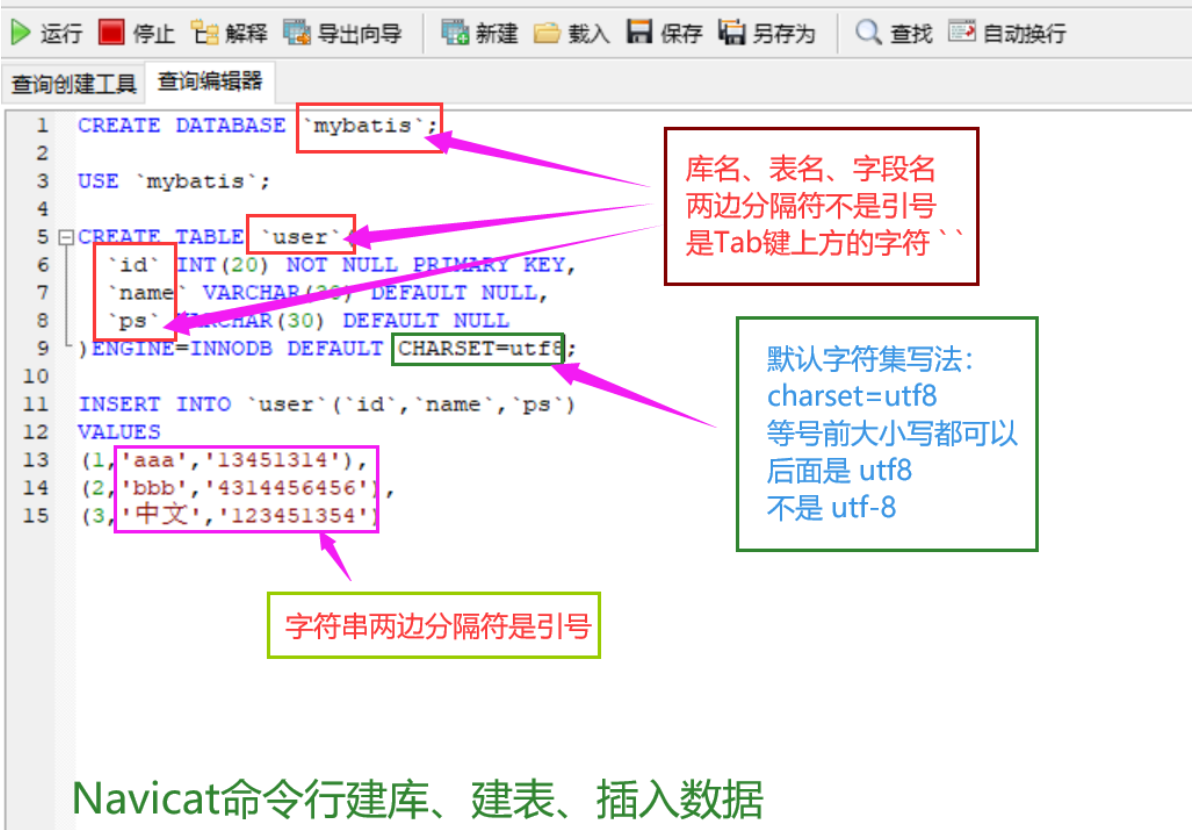
2.2、配置pom.xml
<?xml version="1.0" encoding="UTF-8"?>
<project xmlns="http://maven.apache.org/POM/4.0.0"
xmlns:xsi="http://www.w3.org/2001/XMLSchema-instance"
xsi:schemaLocation="http://maven.apache.org/POM/4.0.0
http://maven.apache.org/xsd/maven-4.0.0.xsd">
<parent>
<artifactId>mybatis-study</artifactId>
<groupId>com.ajun</groupId>
<version>1.0-SNAPSHOT</version>
</parent>
<modelVersion>4.0.0</modelVersion>
<artifactId>mybatis-01</artifactId>
<properties>
<maven.compiler.source>8</maven.compiler.source>
<maven.compiler.target>8</maven.compiler.target>
</properties>
<dependencies>
<!--测试包-->
<dependency>
<groupId>junit</groupId>
<artifactId>junit</artifactId>
<version>4.13.2</version>
<scope>test</scope>
</dependency>
<!--mysql驱动包-->
<dependency>
<groupId>mysql</groupId>
<artifactId>mysql-connector-java</artifactId>
<version>8.0.25</version>
</dependency>
<!--mybatis包-->
<dependency>
<groupId>org.mybatis</groupId>
<artifactId>mybatis</artifactId>
<version>3.5.7</version>
</dependency>
<dependency>
<groupId>org.projectlombok</groupId>
<artifactId>lombok</artifactId>
<version>1.18.20</version>
<scope>provided</scope>
</dependency>
</dependencies>
</project>
2.3、配置mybatis-config.xml
<?xml version="1.0" encoding="UTF-8" ?>
<!DOCTYPE configuration
PUBLIC "-//mybatis.org//DTD Config 3.0//EN"
"http://mybatis.org/dtd/mybatis-3-config.dtd">
<configuration>
<environments default="development">
<environment id="development">
<transactionManager type="JDBC"/>
<dataSource type="POOLED">
<property name="driver" value="com.mysql.cj.jdbc.Driver"/>
<property name="url" value="jdbc:mysql://localhost:3306/mybatis?useSSL=true&useUnicode=true&characterEncoding=utf8"/>
<property name="username" value="root"/>
<property name="password" value="123456"/>
</dataSource>
</environment>
</environments>
</configuration>
2.4、建立mybatis工具类
因为获取SqlSession的操作是固定不变的,所以用工具类的形式实现,方便后面调用
//sqlSessionFactory --> sqlSession
public class MyBatisUtils {
private static SqlSessionFactory sqlSessionFactory;
static {
try {
//使用mybatis第一步:获取sqlSessionFactory对象
String resource = "mybatis-config.xml";
InputStream inputStream = Resources.getResourceAsStream(resource);
sqlSessionFactory = new SqlSessionFactoryBuilder().build(inputStream);
} catch (IOException e) {
e.printStackTrace();
}
}
//既然有了 SqlSessionFactory,就可以从中获得 SqlSession 的实例。
// SqlSession 提供了在数据库执行 SQL 命令所需的所有方法。
// 可以通过 SqlSession 实例来直接执行已映射的 SQL 语句
//openSession(boolean autoCommit)可以添加参数,是否自动提交事务。默认为false,不自动提交
public static SqlSession getSqlSession(){
return sqlSessionFactory.openSession();
}
}
2.5、实体类 User.java
@Data
public class User {
private int id;
private String name;
private String ps;
}
2.6、Dao接口类 UserDao.java
public interface UserDao {
public List<User> getAll();
}
2.7、接口配置 UserDao.xml
<?xml version="1.0" encoding="UTF-8" ?>
<!DOCTYPE mapper
PUBLIC "-//mybatis.org//DTD Mapper 3.0//EN"
"http://mybatis.org/dtd/mybatis-3-mapper.dtd">
<mapper namespace="com.ajun.dao.UserDao">
<select id="getAll" resultType="User">
select * from mybatis.user;
</select>
</mapper>
命名空间namespace使用全限定名
2.8、两种配置文件结构对比
mybatis-config.xml 与 mapper.xml结构对比
mapper.xml(即Dao映射配置文件)
结构相同,关键字不同
- mybatis-config.xml
<?xml version="1.0" encoding="UTF-8" ?>
<!DOCTYPE configuration
PUBLIC "-//mybatis.org//DTD Config 3.0//EN"
"http://mybatis.org/dtd/mybatis-3-config.dtd">
<configuration>
</configuration>
- mapper.xml
<?xml version="1.0" encoding="UTF-8" ?>
<!DOCTYPE mapper
PUBLIC "-//mybatis.org//DTD Mapper 3.0//EN"
"http://mybatis.org/dtd/mybatis-3-mapper.dtd">
<mapper namespace="">
</mapper>

2.9、注册映射器UserDao.xml
在mybatis-config.xml中添加:
每一个dao.xml都需要注册
四种写法
<mappers>
<!-- 写法1
<package name="com.ajun.dao"/>
-->
<!-- 写法2:不建议用
<mapper url="file:///var/mappers/AuthorMapper.xml"/>
-->
<!-- 写法3
<mapper class="com.ajun.dao.UserDao"/>
-->
<!-- 写法4 -->
<mapper resource="com/ajun/dao/UserDao.xml"/>
</mappers>
2.10、配置Maven静态资源过滤
<build>
<resources>
<resource>
<directory>src/main/java</directory>
<includes>
<include>**/*.properties</include>
<include>**/*.xml</include>
</includes>
<!--false:表示不启用过滤器-->
<filtering>false</filtering>
</resource>
</resources>
</build>
使用Maven构建项目的时候,会默认过滤掉静态资源,所以,需要手动来配置
静态资源 : 包含HTMl,图片,CSS,JS,xml等不需要与数据库交互的一类文件
动态资源 : 需要与数据库交互,可以根据需要显示不同的数据,不需要修改页面
2.11、测试
public class MyTest {
@Test
public void test(){
SqlSession sqlSession = MyBatisUtils.getSqlSession();
try{
UserDao userDao = sqlSession.getMapper(UserDao.class);
List<User> users = userDao.getAll();
for (User user : users) {
System.out.println(user);
}
}finally {
//关闭sqlSession
sqlSession.close();
}
}
}
把关闭操作放在finally中

3、增删改查CRUD
- 增加(Create)
- 检索(Retrieve)
- 更新(Update)
- 删除(Delete)
3.1、Mapper.xml中命名空间
Mapper.xml中命名空间和Dao的全限定名一致

3.2、添加、修改、删除
在SqlSessionFactory的openSession()中,默认不自动提交事务。所以增删改操作要提交事务,才能操作成功。sqlSession.commit()
SqlSessionFactory的openSession()方法可以添加参数:boolean autoCommit
是否自动提交事务,默认为false,不自动提交
实体类:User.java
//添加用户
int addUser(User user);
//修改用户
int updateUser(User user);
//删除用户
int deleteUser(int id);
Mapper.xml配置文件
<insert id="addUser" parameterType="User">
insert into mybatis.user (id, name, ps) values (#{id},#{name},#{ps});
</insert>
<update id="updateUser" parameterType="User">
update mybatis.user set name = #{name},ps = #{ps} where id = #{id};
</update>
<delete id="deleteUser" parameterType="int">
delete from mybatis.user where id = #{id};
</delete>
测试类
@Test
public void addUser(){
SqlSession sqlSession = MyBatisUtils.getSqlSession();
try{
UserMapper userMapper = sqlSession.getMapper(UserMapper.class);
userMapper.addUser(new User(5,"测试","464655646"));
//要提交事务
sqlSession.commit();
}finally {
sqlSession.close();
}
}
@Test
public void updateUser(){
SqlSession sqlSession = MyBatisUtils.getSqlSession();
try{
UserMapper userMapper = sqlSession.getMapper(UserMapper.class);
userMapper.updateUser(new User(5,"成功","4546545464444464"));
//要提交事务
sqlSession.commit();
}finally {
sqlSession.close();
}
}
@Test
public void deleteUser(){
SqlSession sqlSession = MyBatisUtils.getSqlSession();
try{
UserMapper mapper = sqlSession.getMapper(UserMapper.class);
mapper.deleteUser(5);
//要提交事务
sqlSession.commit();
}finally {
sqlSession.close();
}
}
3.3、Dao中用Map参数
假如实体类属性过多,用map,传递map的key。万能方法
Dao接口类
User getUserByMap(Map<String,Object> map);
Mapper配置
<select id="getUserByMap" parameterType="map" resultType="User">
select * from mybatis.user where id = #{key};
</select>
测试类
@Test
public void getUserByMap(){
SqlSession sqlSession = MyBatisUtils.getSqlSession();
try{
UserMapper userMapper = sqlSession.getMapper(UserMapper.class);
Map<String,Object> map = new HashMap<String,Object>();
map.put("key",3);
User user = userMapper.getUserByMap(map);
System.out.println(user);
}finally {
//关闭sqlSession
sqlSession.close();
}
}

3.4、模糊查询
like %value%
关键字两端加通配符%
通配符可以加在sql语句中
select * from mybatis.user where name like "%"#{value}"%"
也可以加在调用方法中
List<User> users = mapper.getUserLike("%文%");
Dao接口类
//模糊查询
List<User> getUserLike(String value);
Mapper配置
<select id="getUserLike" parameterType="String" resultType="User">
select * from mybatis.user where name like #{value};
</select>
测试类
@Test
public void getUserLike(){
SqlSession sqlSession = MyBatisUtils.getSqlSession();
try{
UserMapper mapper = sqlSession.getMapper(UserMapper.class);
List<User> users = mapper.getUserLike("%文%");
for (User user : users) {
System.out.println(user);
}
}finally {
sqlSession.close();
}
}

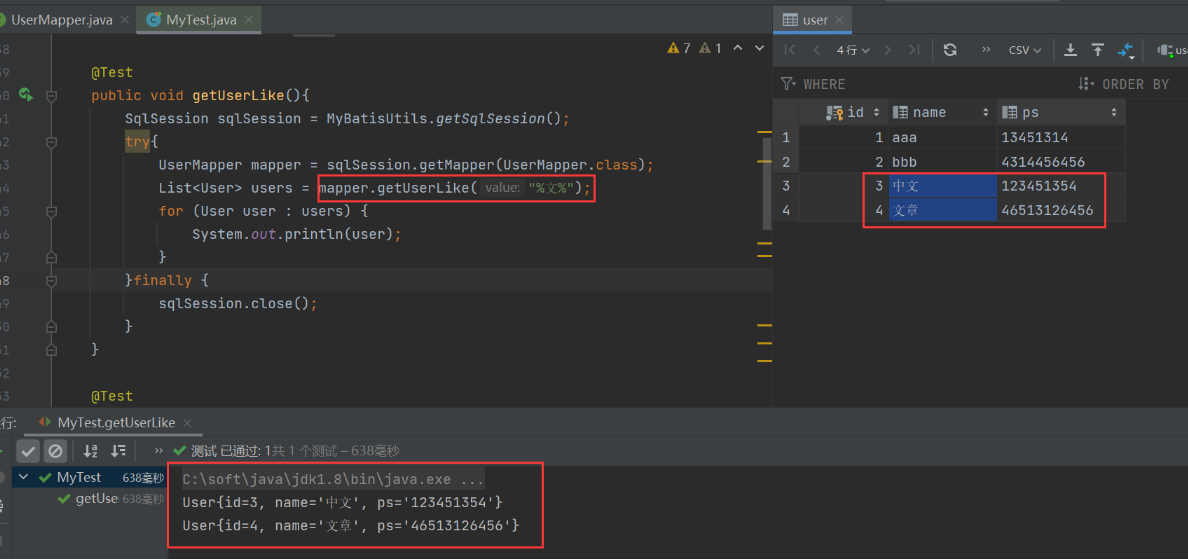
4、配置解析
4.1、核心配置文件
-
mybatis-config.xml
MyBatis 的配置文件包含了会深深影响 MyBatis 行为的设置和属性信息。 配置文档的顶层结构如下:
configuration(配置)
- properties(属性)
- settings(设置)
- typeAliases(类型别名)
- typeHandlers(类型处理器)
- objectFactory(对象工厂)
- plugins(插件)
- environments(环境配置)
- environment(环境变量)
- transactionManager(事务管理器)
- dataSource(数据源)
- environment(环境变量)
- databaseIdProvider(数据库厂商标识)
- mappers(映射器)
以上配置按从上到下的顺序,不能乱
4.2、环境配置(environments)
MyBatis 可以配置成适应多种环境 (例如,开发、测试和生产环境需要有不同的配置)
不过要记住:尽管可以配置多个环境,但每个 SqlSessionFactory 实例只能选择一种环境。
-
每个数据库对应一个 SqlSessionFactory 实例
为了指定创建哪种环境,只要将它作为可选的参数传递给 SqlSessionFactoryBuilder 即可。可以接受环境配置的两个方法签名是:
SqlSessionFactory factory = new SqlSessionFactoryBuilder().build(reader, environment); SqlSessionFactory factory = new SqlSessionFactoryBuilder().build(reader, environment, properties);
environments 元素定义了如何配置环境
<environments default="development">
<environment id="development">
<transactionManager type="JDBC">
<property name="..." value="..."/>
</transactionManager>
<dataSource type="POOLED">
<property name="driver" value="${driver}"/>
<property name="url" value="${url}"/>
<property name="username" value="${username}"/>
<property name="password" value="${password}"/>
</dataSource>
</environment>
</environments>
注意一些关键点:
- 默认使用的环境 ID(比如:default="development")。
- 每个 environment 元素定义的环境 ID(比如:id="development")。
- 事务管理器的配置(比如:type="JDBC")。
- 数据源的配置(比如:type="POOLED")。
默认环境和环境 ID 顾名思义。 环境可以随意命名,但务必保证默认的环境 ID 要匹配其中一个环境 ID。
事务管理器(transactionManager)
在 MyBatis 中有两种类型的事务管理器(也就是 type="[JDBC|MANAGED]")
提示 如果你正在使用 Spring + MyBatis,则没有必要配置事务管理器,因为 Spring 模块会使用自带的管理器来覆盖前面的配置。
数据源(dataSource)
dataSource 元素使用标准的 JDBC 数据源接口来配置 JDBC 连接对象的资源。
有三种内建的数据源类型(也就是 type="[UNPOOLED|POOLED|JNDI]")
-
UNPOOLED
不用连接池
-
POOLED
连接池
-
JNDI
这个数据源实现是为了能在如 EJB 或应用服务器这类容器中使用
4.3、属性(properties)
这些属性可以在外部进行配置,并可以进行动态替换。既可以在典型的 Java 属性文件中配置这些属性,也可以在 properties 元素的子元素中设置。
外部配置文件:db.properties
driver = com.mysql.cj.jdbc.Driver
url = jdbc:mysql://localhost:3306/mybatis?useSSL=true&useUnicode=true&characterEncoding=utf8&serverTimezone=GMT
username = root
password = 123456
由于mysql的驱动发生了更新,之前的链接方式需要改变,加入时区
之前:jdbc:mysql://localhost:3306/mybatis?useSSL=true&useUnicode=true&characterEncoding=utf-8
现在:jdbc:mysql://localhost:3306/mybatis?useSSL=true&useUnicode=true&characterEncoding=utf-8&serverTimezone = GMT
引用:
<!--引用外部配置-->
<properties resource="db.properties"/>
<dataSource type="POOLED">
<property name="driver" value="${driver}"/>
<property name="url" value="${url}"/>
<property name="username" value="${username}"/>
<property name="password" value="${password}"/>
</dataSource>
<!--properties中可以加入别的属性,同时有的话,优先走外面properties-->
<properties resource="db.properties">
<property name="username" value="root"></property>
<property name="password" value="123456"></property>
</properties>
4.4、类型别名(typeAliases)
类型别名可为 Java 类型设置一个缩写名字。 它仅用于 XML 配置,意在降低冗余的全限定类名书写
- 特定类起别名
<typeAliases>
<typeAlias alias="User" type="com.ajun.pojo.User"/>
</typeAliases>
当这样配置时,User 可以用在任何使用 com.ajun.pojo.User 的地方
- 包下所有类起别名
<typeAliases>
<package name="com.ajun.pojo"/>
</typeAliases>
每一个在包 com.ajun.pojo 中的 Java Bean,在没有注解的情况下,会使用 Bean 的首字母小写的非限定类名来作为它的别名,(大写User也可以,但不建议)。 比如 com.ajun.pojo.User 的别名为 user;若有注解,则别名为其注解值。
下面是一些为常见的 Java 类型内建的类型别名。它们都是不区分大小写的,注意,为了应对原始类型的命名重复,采取了特殊的命名风格。
| 别名 | 映射的类型 |
|---|---|
| _byte | byte |
| _long | long |
| _short | short |
| _int | int |
| _integer | int |
| _double | double |
| _float | float |
| _boolean | boolean |
| string | String |
| byte | Byte |
| long | Long |
| short | Short |
| int | Integer |
| integer | Integer |
| double | Double |
| float | Float |
| boolean | Boolean |
| date | Date |
| decimal | BigDecimal |
| bigdecimal | BigDecimal |
| object | Object |
| map | Map |
| hashmap | HashMap |
| list | List |
| arraylist | ArrayList |
| collection | Collection |
| iterator | Iterator |
4.5、设置(settings)
这是 MyBatis 中极为重要的调整设置,它们会改变 MyBatis 的运行时行为。
| 设置名 | 描述 | 有效值 | 默认值 |
|---|---|---|---|
| cacheEnabled | 全局性地开启或关闭所有映射器配置文件中已配置的任何缓存。 | true | false | true |
| lazyLoadingEnabled | 延迟加载的全局开关。当开启时,所有关联对象都会延迟加载。 特定关联关系中可通过设置 fetchType 属性来覆盖该项的开关状态。 |
true | false | false |
| logImpl | 指定 MyBatis 所用日志的具体实现,未指定时将自动查找。 | SLF4J | LOG4J | LOG4J2 | JDK_LOGGING | COMMONS_LOGGING | STDOUT_LOGGING | NO_LOGGING | 未设置 |
详细设置查看:https://mybatis.org/mybatis-3/zh/configuration.html#settings
4.6、其它配置
- typeHandlers(类型处理器)
- objectFactory(对象工厂)
- plugins(插件)
5、映射器(mappers)
就是告诉 MyBatis 去哪里找映射文件(SQL语句)。
不支持通配符。推荐用package,可以指定包下的所有配置文件。
resource和class需要一个一个地配置
四种配置方法:
1、resource
<!-- 使用相对于类路径的资源引用 -->
<mappers>
<mapper resource="org/mybatis/builder/AuthorMapper.xml"/>
</mappers>
2、url(不建议用)
<!-- 使用完全限定资源定位符(URL) -->
<mappers>
<mapper url="file:///var/mappers/AuthorMapper.xml"/>
</mappers>
3、class
<!-- 使用映射器接口实现类的完全限定类名 -->
<mappers>
<mapper class="org.mybatis.builder.AuthorMapper"/>
</mappers>
4、package(推荐)
<!-- 将包内的映射器接口实现全部注册为映射器 -->
<mappers>
<package name="org.mybatis.builder"/>
</mappers>
注意:用class 和 package时,接口名和配置文件名一致,且在同一个包下
6、作用域(Scope)和生命周期
-
SqlSessionFactoryBuilder
作用就是创建SqlSessionFactory。创建完之后就可以丢弃。
-
SqlSessionFactory
相当于数据源连接池,会伴随程序运行的全过程。可以生成多个SqlSession。应当设为单例模式,全局唯一。
-
SqlSession
相当于特定的一次请求,一个连接。请求完之后就关闭。不是线程安全的,不可以共享。
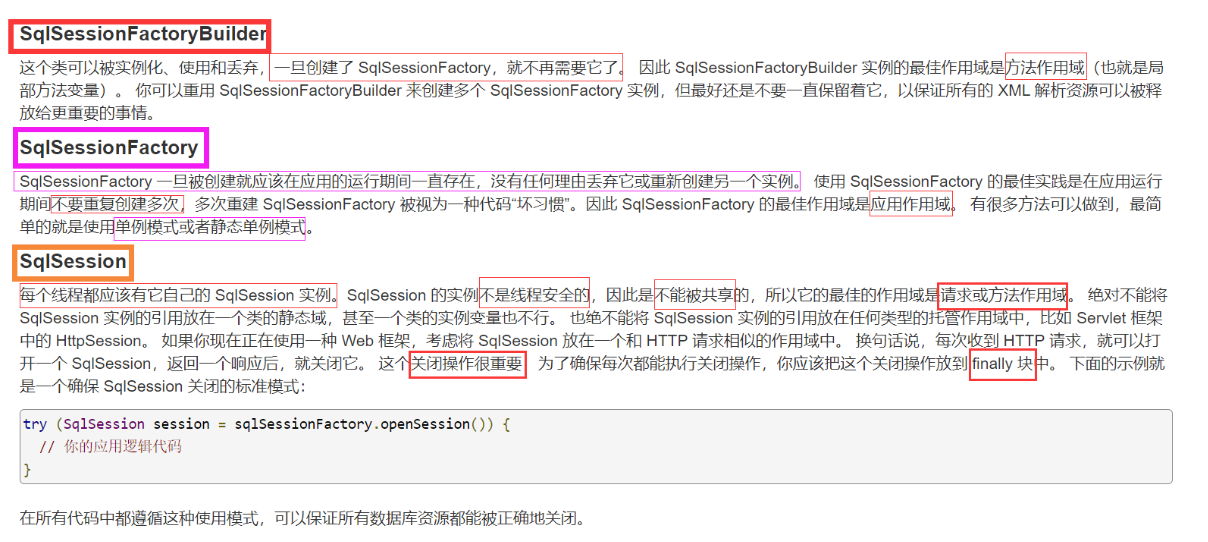
7、结果映射resultMap
resultMap 元素是 MyBatis 中最重要最强大的元素。
ResultMap 的设计思想是,对简单的语句做到零配置,对于复杂一点的语句,只需要描述语句之间的关系就行了。
7.1、实体属性名与数据库列名不一致
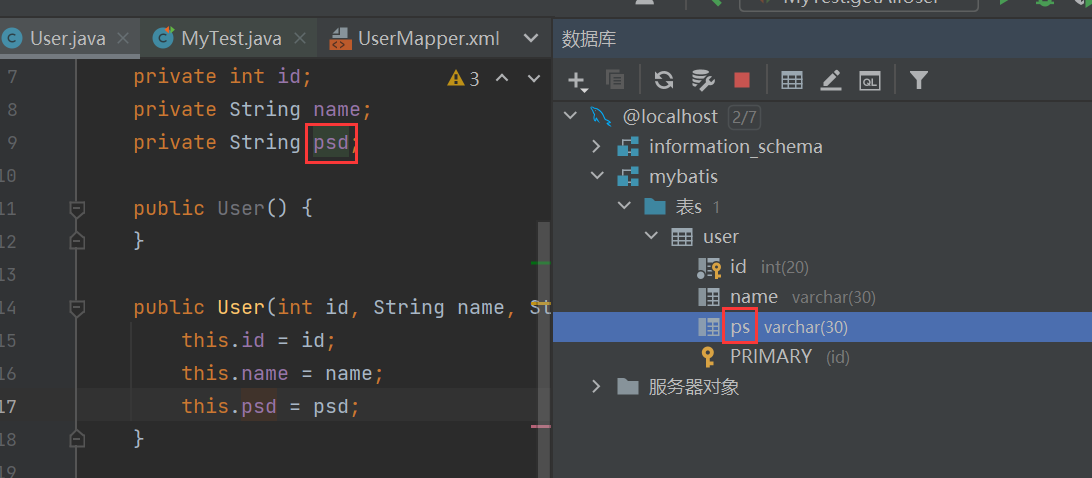
解决办法:
1、指定别名
把字段名 ps 指定为 属性名 psd,采用 as
<select id="getAllUser" resultType="user">
select id,name,ps as psd from mybatis.user;
</select>
2、结果集映射resultMap
<!--调用结果集-->
<select id="getAllUser" resultMap="userResultMap">
select * from mybatis.user;
</select>
<!--结果集映射-->
<resultMap id="userResultMap" type="user">
<!--
名字一致时可以省略
<result property="id" column="id"/>
<result property="name" column="name"/>
-->
<result property="psd" column="ps"/>
</resultMap>
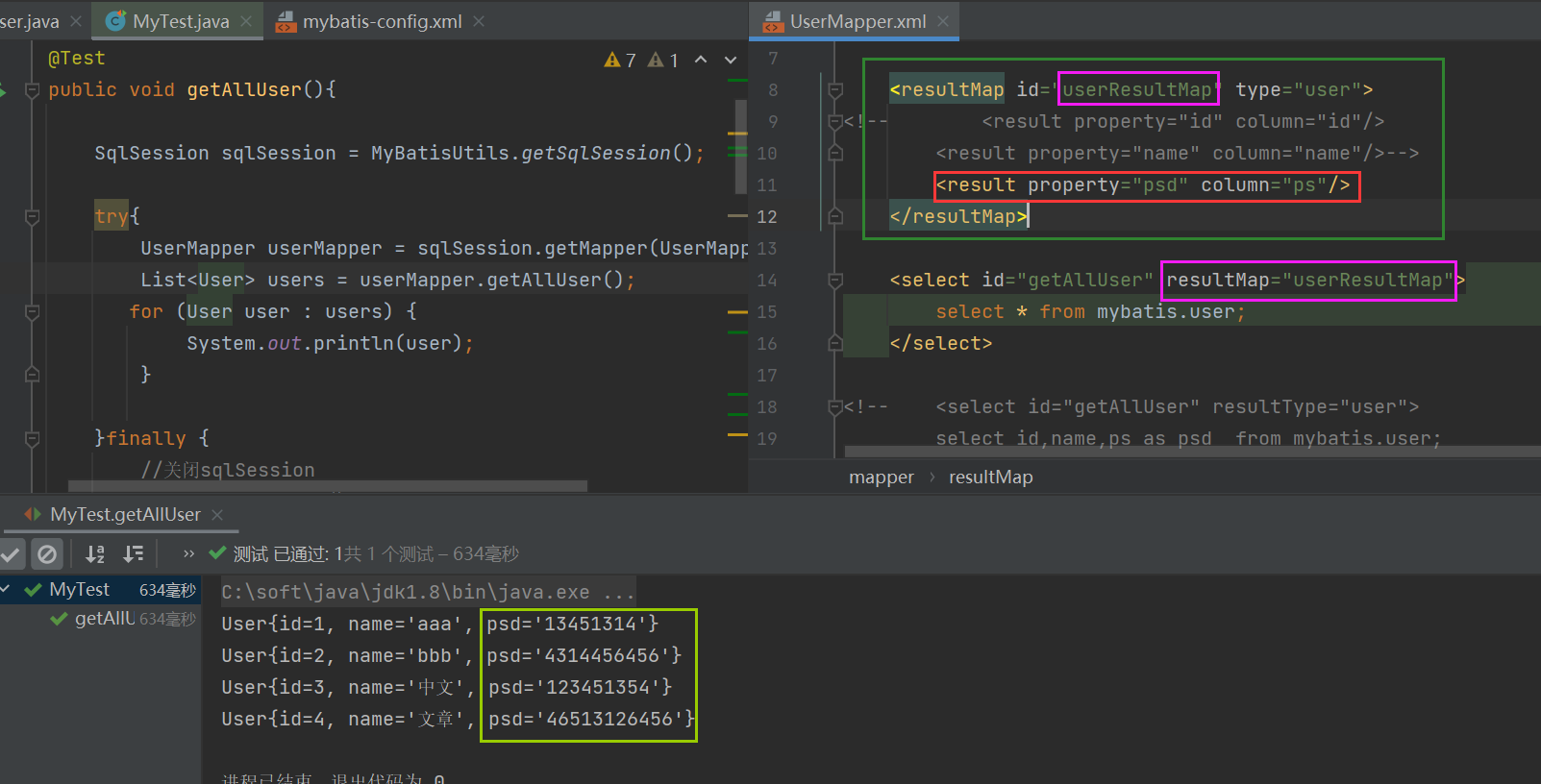
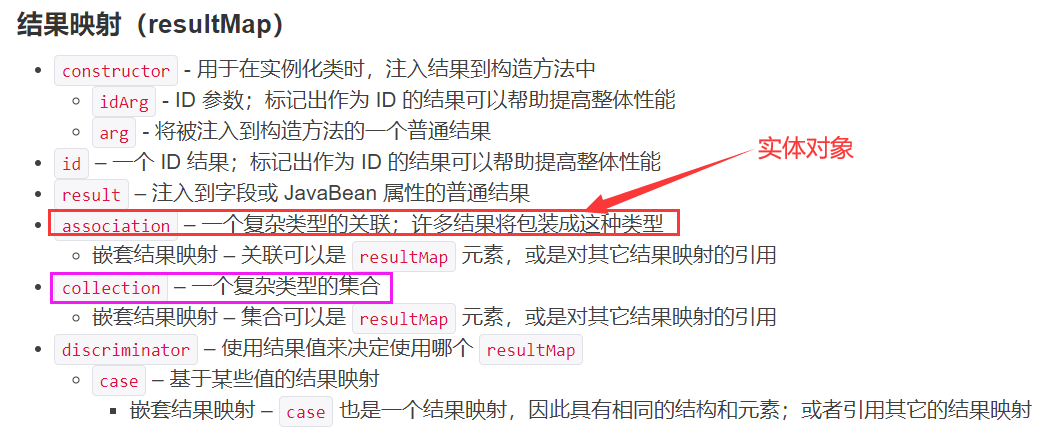
8、日志
8.1、日志工厂
| 设置名 | 描述 | 有效值 | 默认值 |
|---|---|---|---|
| logImpl | 指定 MyBatis 所用日志的具体实现,未指定时将自动查找。 | SLF4J | LOG4J | LOG4J2 | JDK_LOGGING | COMMONS_LOGGING | STDOUT_LOGGING | NO_LOGGING | 未设置 |
- SLF4J
- LOG4J [掌握]
- LOG4J2
- JDK_LOGGING
- COMMONS_LOGGING
- STDOUT_LOGGING [掌握] 控制台输出
- NO_LOGGING
具体使用哪一个,在设置中设定
STDOUT_LOGGING 标准日志输出 (控制台输出)
mybatis-config中
<settings>
<setting name="logImpl" value="STDOUT_LOGGING"/>
</settings>
注意格式:大小写敏感,不能有空格
8.2、Log4j
8.2.1、介绍
-
Log4j是Apache的一个开源项目,可以控制日志信息输送的目的地是控制台、文件、GUI组件
-
可以控制每一条日志的输出格式;
-
通过定义每一条日志信息的级别,能够更加细致地控制日志的生成过程。
-
可以通过一个配置文件来灵活地进行配置,而不需要修改应用的代码。
8.2.2、导入jar包
<dependency>
<groupId>log4j</groupId>
<artifactId>log4j</artifactId>
<version>1.2.17</version>
</dependency>
8.2.3、配置log4j.properties
### set log levels ###
log4j.rootLogger = DEBUG,console,file
### 输出到控制台 ###
log4j.appender.console = org.apache.log4j.ConsoleAppender
log4j.appender.console.Target = System.out
log4j.appender.console.Threshold = DEBUG
log4j.appender.console.layout = org.apache.log4j.PatternLayout
log4j.appender.console.layout.ConversionPattern = [%c]-%m%n
### 输出到日志文件 ###
log4j.appender.file=org.apache.log4j.RollingFileAppender
log4j.appender.file.File=./log/ajun.log
log4j.appender.file.MaxFileSize=10mb
log4j.appender.file.Threshold=DEBUG
log4j.appender.file.layout=org.apache.log4j.PatternLayout
log4j.appender.file.layout.ConversionPattern=[%p][%d{yy-MM-dd}][%c]%m%n
# 日志输出级别
log4j.logger.org.mybatis=DEBUG
log4j.logger.java.sql=DEBUG
log4j.logger.java.sql.Statement=DEBUG
log4j.logger.java.sql.ResultSet=DEBUG
log4j.logger.java.sql.PreparedStatement=DEBUG
8.2.4、mybatis中配置log4j
<settings>
<setting name="logImpl" value="LOG4J"/>
</settings>
8.2.5、使用
-
在要使用log4j的类中,导入包 org.apache.log4j.Logger
import org.apache.log4j.Logger; -
获取日志对象,参数为当前类的class
Logger logger = Logger.getLogger(MyTest.class); -
日志级别
logger.info("info信息"); logger.debug("debug信息"); logger.error("error信息");
9、分页
9.1、limit分页【重点】
9.1.1、SQL
select * from 表名 limit startIndex , pageSize;
select * form 表名 limit pageSize; //startIndex默认为0
startIndex:起始位置
pageSize:一次查询的数量
startIndex省略时,默认从0开始
9.1.2、接口方法
//分页查询
List<User> getUserByPage(Map<String,Integer> map);
9.1.3、Mapper.xml配置
<resultMap id="userResultMap" type="user">
<result property="psd" column="ps"/>
</resultMap>
<select id="getUserByPage" parameterType="map" resultMap="userResultMap">
select * from mybatis.user limit #{startIndex},#{pageSize};
</select>
9.1.4、测试类
@Test
public void getUserByPage(){
SqlSession sqlSession = MyBatisUtils.getSqlSession();
try{
UserMapper mapper = sqlSession.getMapper(UserMapper.class);
Map<String,Integer> map = new HashMap<String,Integer>();
map.put("startIndex",2);
map.put("pageSize",2);
List<User> users = mapper.getUserByPage(map);
for (User user : users) {
System.out.println(user);
}
}finally {
sqlSession.close();
}
}

9.2、RowBounds分页 (面向对象)
不建议使用
9.3、分页插件
Mybatis PageHelper
10、注解开发
不建议使用。没有xml配置sql形式功能强大。
10.1、接口类 UserMapper.java
public interface UserMapper {
//查询全部
@Select("select * from user")
List<User> getAllUser();
}
10.2、Mybatis-config.xml配置
<mappers>
<!--用class来配置-->
<mapper class="com.ajun.mapper.UserMapper"/>
</mappers>
使用注解来映射简单语句会使代码显得更加简洁,但对于稍微复杂一点的语句,Java 注解不仅力不从心,还会让本就复杂的 SQL 语句更加混乱不堪。 因此,如果需要做一些很复杂的操作,最好用 XML 来映射语句。
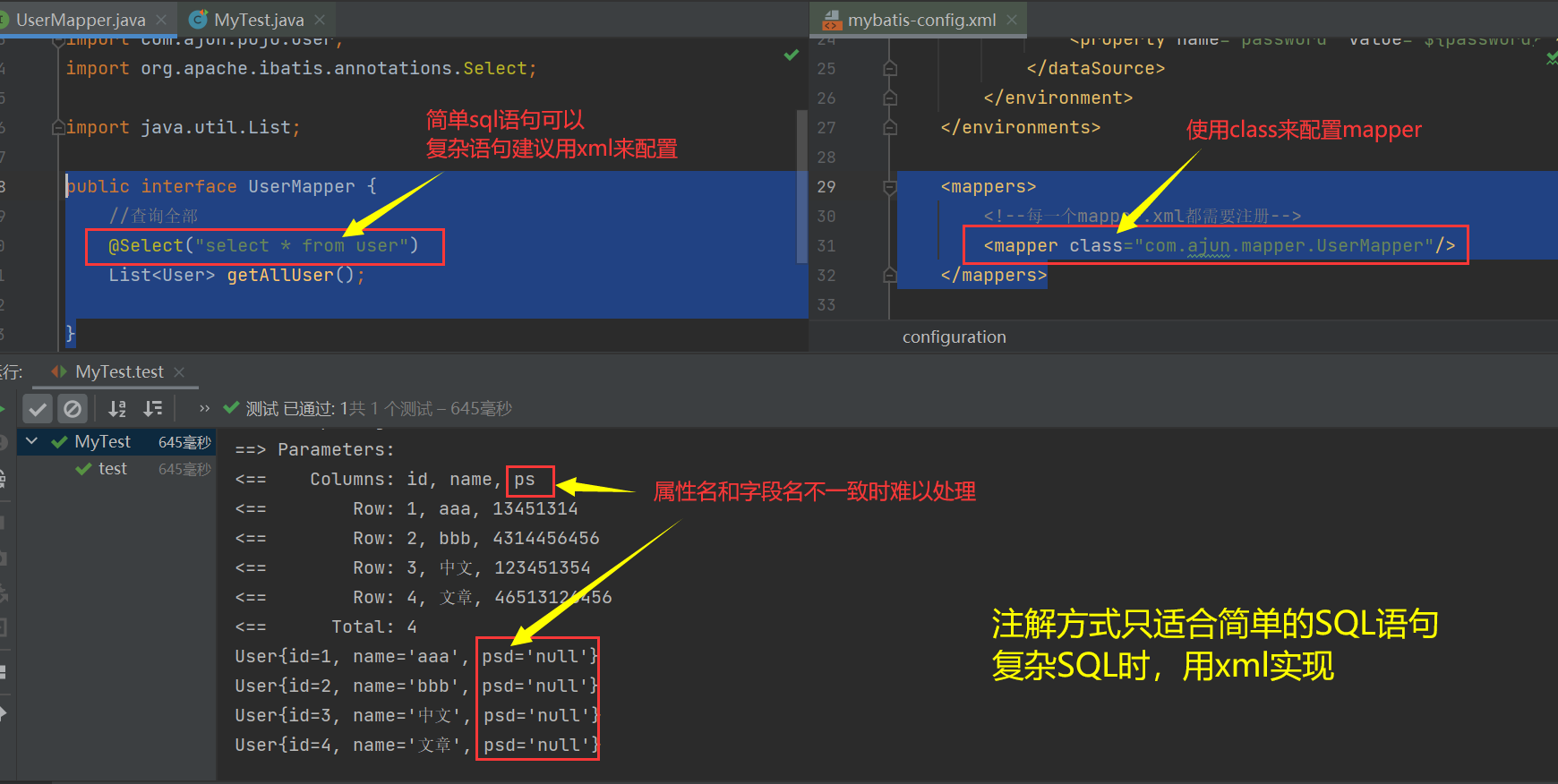
本质:反射机制
底层:动态代理!
10.3、自动提交事务
SqlSessionFactory的openSession()方法,默认不自动提交事务。可以接受参数:
//默认为false,不自动提交事务
openSession(boolean autoCommit);
//true时,就可以自动提交事务
openSession(true);
实际开发中不建议自动提交。
10.4、@Param()注解
- 基本类型的参数或String类型的参数,需要加上
- 对象参数不需要加
- 如果只有一个基本类型参数,可以省略,建议加上
- SQL语句中的参数#{uid},和@Param()中的参数"uid"是对应的
int addUser(@Param("id") id,@Param("name") name,@Param("psd") ps);
int addUser(User user);//对象类型,不需要加
int deleteUser(int id);//只有一个基本类型参数,可以省略
//SQL语句中的参数#{uid},和@Param()中的参数"uid"是对应的
@Select("select * from user where id = #{uid}")
User getUserById(@Param("uid") id);
10.5、#{} 和 ${}
MyBatis中使用parameterType向SQL语句传参,parameterType后的类型可以是基本类型int,String,HashMap和java自定义类型。
在SQL中引用这些参数的时候,可以使用两种方式#{parameterName}或者${parameterName}。
- #{}
#将传入的数据都当成一个字符串,会对自动传入的数据加一个双引号。
例如:order by #{parameterName} //或取Map中的value#{Key}也是一样操作。
假设传入参数是“Smith”
会解析成:order by "Smith"
- ${}
$将传入的数据直接显示生成在sql中。
例如:order by #{parameterName} //或取Map中的value#{Key}也是一样操作。
假设传入参数是“Smith”
会解析成:order by Smith
区别:
#方式能够很大程度防止sql注入,$方式无法防止Sql注入。
$方式一般用于传入数据库对象,例如传入表名。
从安全性上考虑,能使用#尽量使用#来传参,因为这样可以有效防止SQL注入的问题。
注意:
MyBatis排序时使用order by 动态参数时需要注意,用$而不是#
例如:ORDER BY ${columnName} //这里MyBatis不会修改或转义字符串,可实现动态传入排序。
建议:接受从用户输出的内容并提供给语句中不变的字符串,这样做是不安全的。这会导致潜在的SQL注入攻击,因此你不应该允许用户输入这些字段,或者通常自行转义并检查。
传入表名称用${}
时间比较,需要为#{},参数尽量用#{},${}容易导致需要有引号的参数失效
11、Mybatis详细执行流程

- Resource获取全局配置文件
- 实例化SqlsessionFactoryBuilder
- 解析配置文件流XMLConfigBuilder
- Configuration所有的配置信息
- SqlSessionFactory实例化
- transactional事务管理
- 创建executor执行器
- 创建SqlSession
- 实现CRUD
- 查看是否执行成功
- 提交事务
- 关闭
12、Lombok
12.1、在IDEA中安装lombok插件
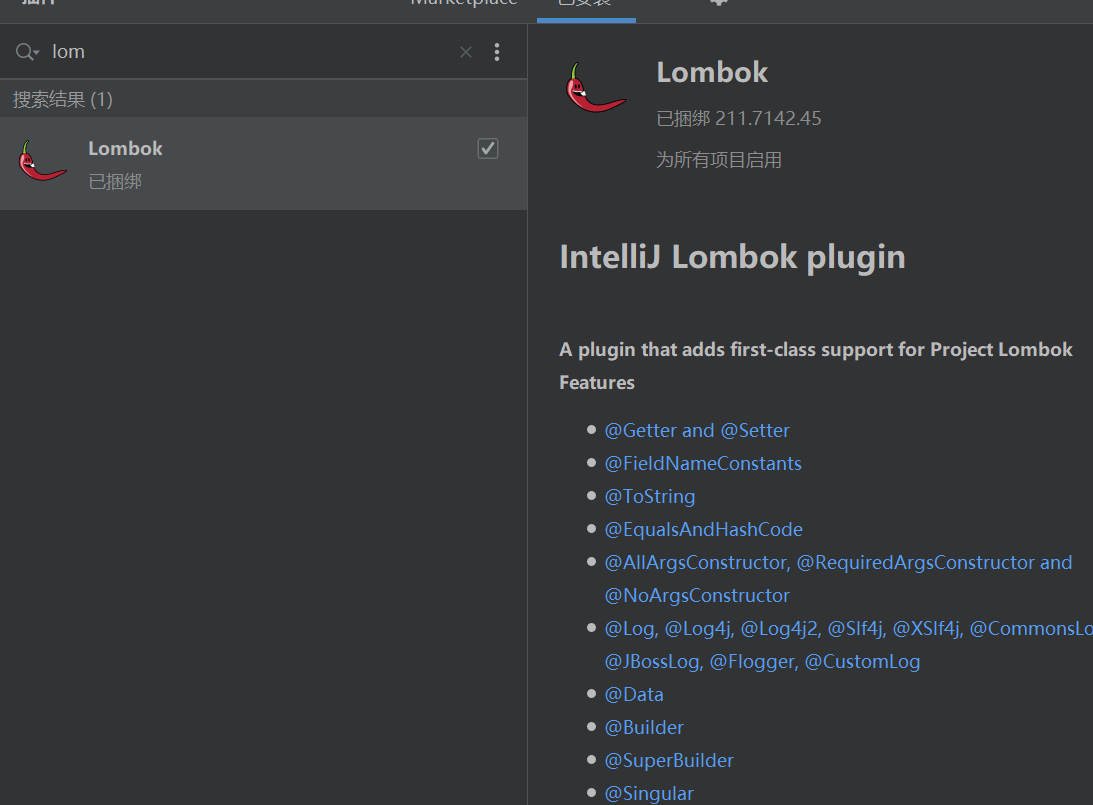
12.2、导入jar包
<dependency>
<groupId>org.projectlombok</groupId>
<artifactId>lombok</artifactId>
<version>1.18.20</version>
<scope>provided</scope><!--开发环境-->
</dependency>
12.3、注解命令
@Getter and @Setter
@FieldNameConstants
@ToString
@EqualsAndHashCode
@AllArgsConstructor, @RequiredArgsConstructor and @NoArgsConstructor //构造器
@Log, @Log4j, @Log4j2, @Slf4j, @XSlf4j, @CommonsLog, @JBossLog, @Flogger, @CustomLog
@Data //重点
@Builder
@SuperBuilder
@Singular
@Delegate
@Value
@Accessors
@Wither
@With
@SneakyThrows
@val
@var
experimental @var
@UtilityClass
Lombok config system
12.3、IDEA中查看类结构
在IDEA中 Alt+F7 可以实时查看类方法
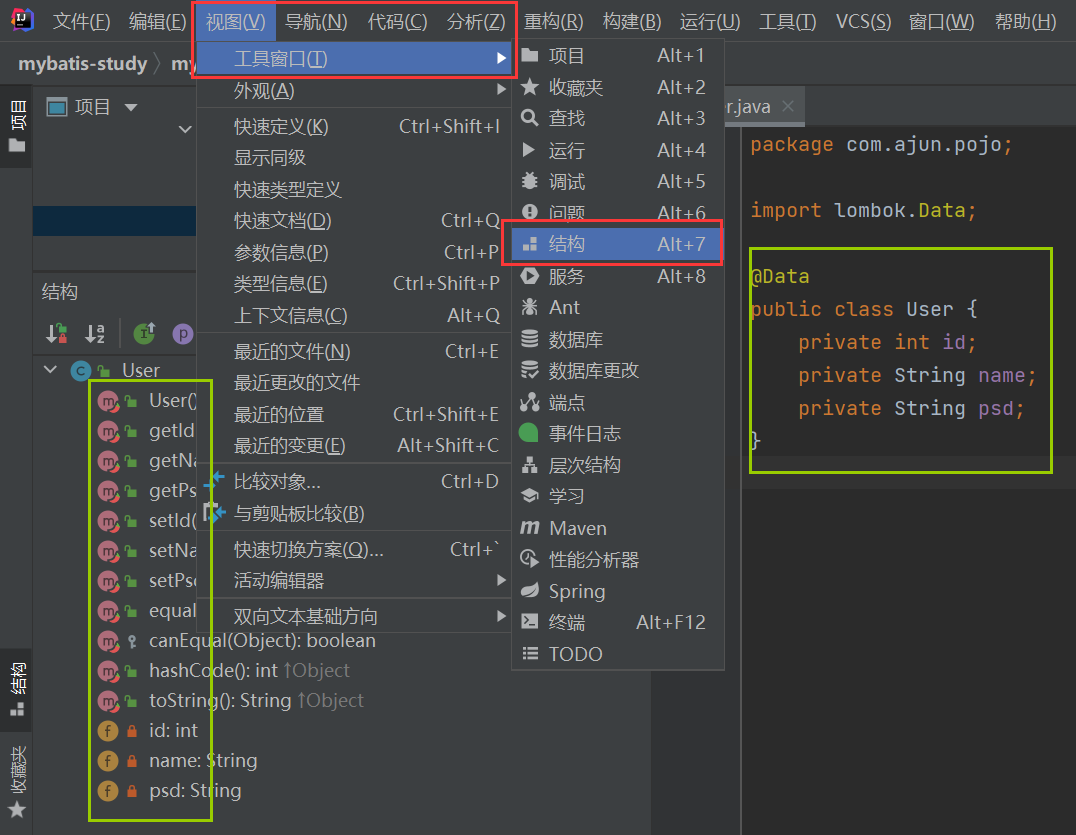
13、多对一
- 多个学生关联一个老师(多对一)
- 一个老师教多个学生 集合(一对多)
13.1、建库
<!--老师表-->
CREATE TABLE `teacher` (
`id` INT(10) NOT NULL PRIMARY KEY,
`name` VARCHAR(30) DEFAULT NULL
)ENGINE=INNODB DEFAULT CHARSET=utf8
<!--老师表插入记录-->
INSERT INTO `teacher` (`id`,`name`) VALUES (1,'阿军');
<!--学生表-->
CREATE TABLE `student` (
`id` INT(10) NOT NULL,
`name` VARCHAR(30) DEFAULT NULL,
`tid` INT(10) DEFAULT NULL,
PRIMARY KEY (`id`),
KEY `fktid` (`tid`),
CONSTRAINT `fktid` FOREIGN KEY (`tid`) REFERENCES `teacher` (`id`)
)ENGINE=INNODB DEFAULT CHARSET=utf8
<!--插入学生数据-->
INSERT INTO student (`id`, `name`, `tid`) VALUES (1, 'xiao1', 1);
INSERT INTO student (`id`, `name`, `tid`) VALUES (2, 'xiao2', 1);
INSERT INTO student (`id`, `name`, `tid`) VALUES (3, 'xiao3', 1);
INSERT INTO student (`id`, `name`, `tid`) VALUES (4, 'xiao4', 1);
INSERT INTO student (`id`, `name`, `tid`) VALUES (5, 'xiao5', 1);

13.2、环境搭建
1、实体类
- Teacher.java
@Data
public class Teacher {
private int id;
private String name;
}
- Student.java
@Data
public class Student {
private int id;
private String name;
private Teacher teacher;
}
2、接口类
- TeacherMapper.java
public interface TeacherMapper {
@Select("select * from teacher where id = #{uid}")
Teacher getTeacher(@Param("uid") int id);
}
- StudentMapper.java
public interface StudentMapper {
}
3、接口配置xml
接口配置文件 TeacherMapper.xml 和 StudentMapper.xml 放入资源resources目录中。在资源目录中创建和接口类一样的目录结构。创建目录时用斜杠 / 分开,如com/ajun/mapper,或者一层一层地创建。如果用com.ajun.mapper创建是不会分层的。和src中的创建方式不一样。src中是包,resources中是文件目录。
把mapper.xml配置文件放入资源目录下后,maven中就不需要静态资源过滤了

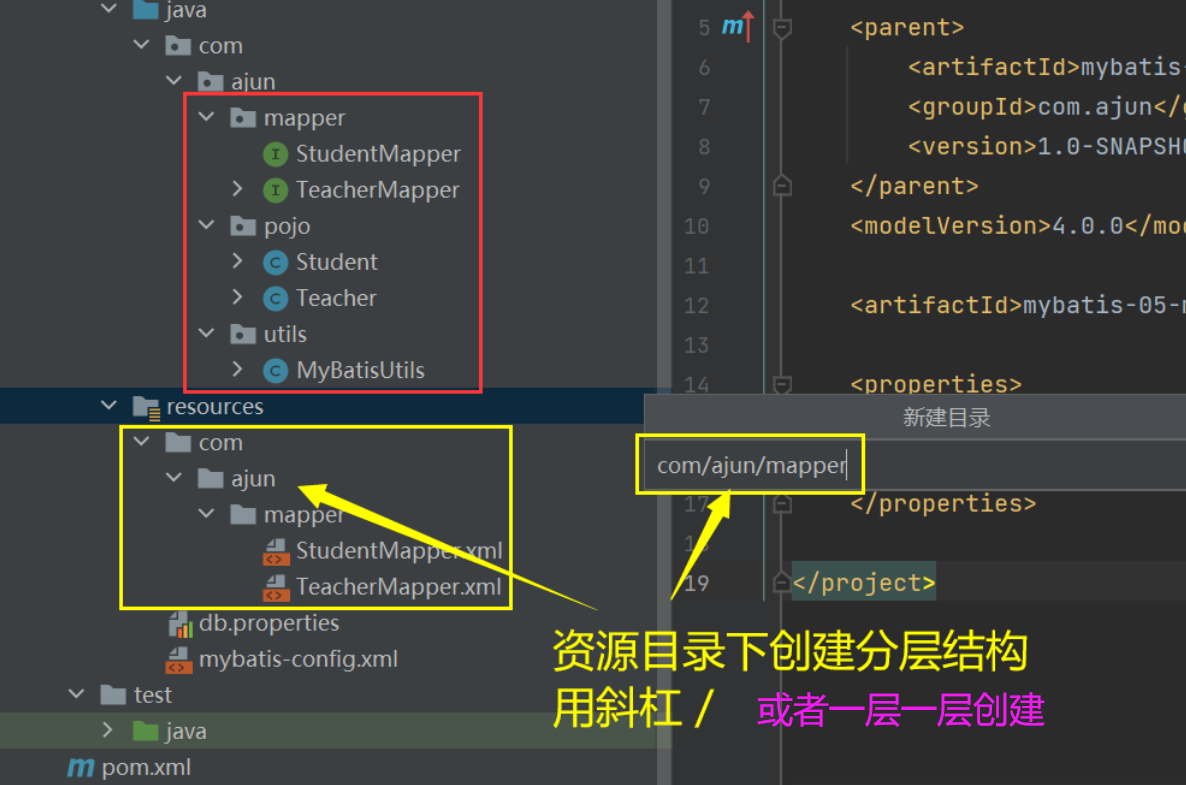
- TeacherMapper.xml
<?xml version="1.0" encoding="UTF-8" ?>
<!DOCTYPE mapper
PUBLIC "-//mybatis.org//DTD Mapper 3.0//EN"
"http://mybatis.org/dtd/mybatis-3-mapper.dtd">
<mapper namespace="com.ajun.mapper.TeacherMapper">
</mapper>
- StudentMapper.xml
<?xml version="1.0" encoding="UTF-8" ?>
<!DOCTYPE mapper
PUBLIC "-//mybatis.org//DTD Mapper 3.0//EN"
"http://mybatis.org/dtd/mybatis-3-mapper.dtd">
<mapper namespace="com.ajun.mapper.StudentMapper">
</mapper>
注:mybatis-config.xml 与 mapper.xml结构模版相同,关键词不同。详见2.8
4、mybatis-config.xml 中添加mapper
就是告诉 MyBatis 去哪里找映射文件(SQL语句)。
不支持通配符。推荐用package,可以指定包下的所有配置文件。
resource和class需要一个一个地配置
四种配置方法。见5
5、工具类
和2.4中一样
6、测试
public class MyTest {
@Test
public void test(){
SqlSession sqlSession = MyBatisUtils.getSession();
try{
TeacherMapper mapper = sqlSession.getMapper(TeacherMapper.class);
Teacher teacher = mapper.getTeacher(1);
System.out.println(teacher);
}finally {
sqlSession.close();
}
}
}
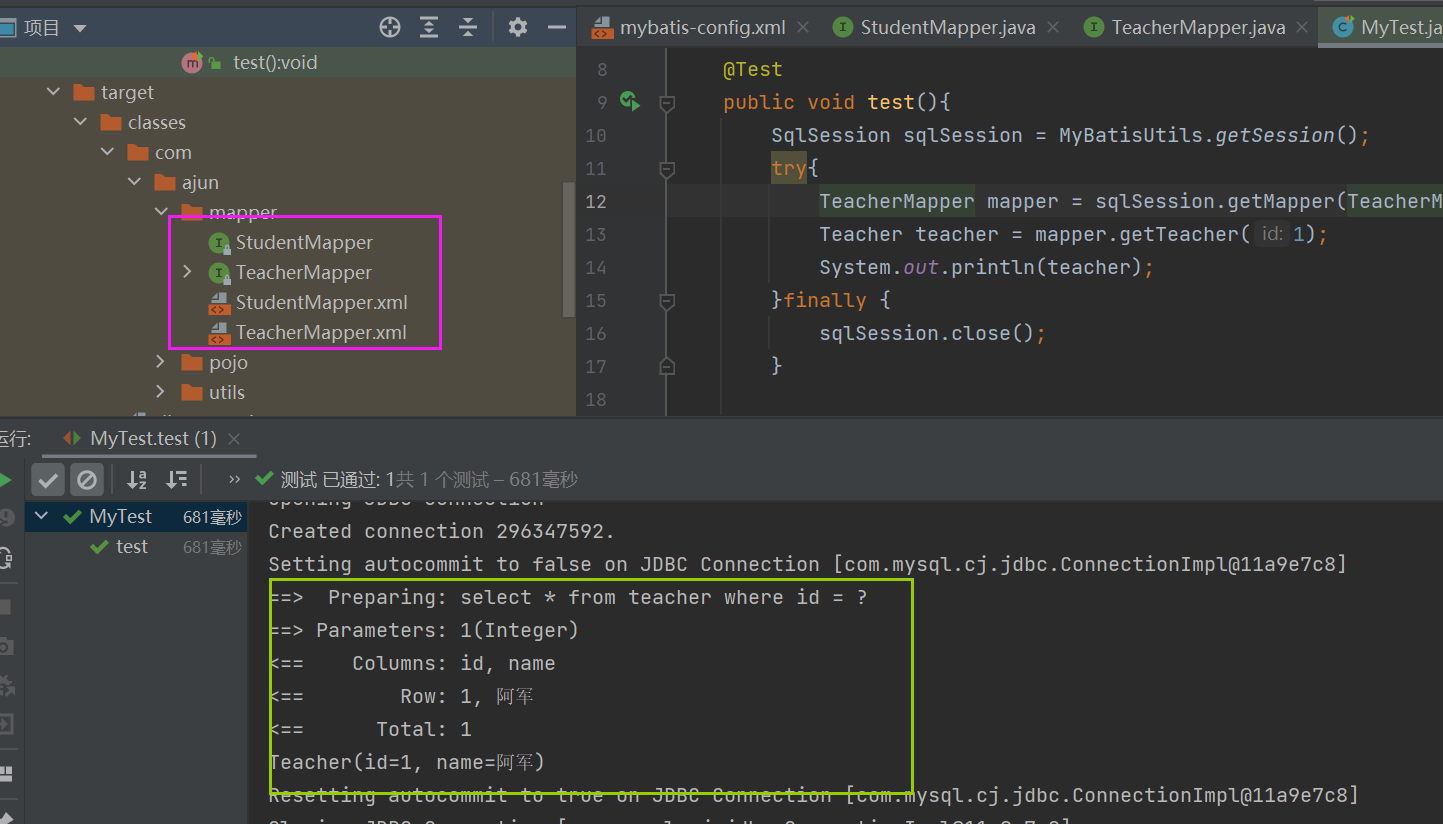
13.3、子查询:查询嵌套处理
- 接口类
public interface StudentMapper {
List<Student> getStudent();
//方式二使用
List<Student> getStudent2();
}
- mapper.xml
<!--按照查询嵌套处理-->
<select id="getStudent" resultMap="studentTeacher">
select * from mybatis.student;
</select>
<resultMap id="studentTeacher" type="student">
<!-- 名字相同时可以省略
<result property="id" column="id"/>
<result property="name" column="name"/>-->
<association property="teacher" column="tid" javaType="teacher" select="getTeacher"/>
</resultMap>
<select id="getTeacher" resultType="teacher">
select * from mybatis.teacher where id = #{tid};
</select>
- 测试
@Test
public void test2(){
SqlSession sqlSession = MyBatisUtils.getSession();
try{
StudentMapper mapper = sqlSession.getMapper(StudentMapper.class);
List<Student> studentList = mapper.getStudent();
for (Student student : studentList) {
System.out.println(student);
}
}finally {
sqlSession.close();
}
}
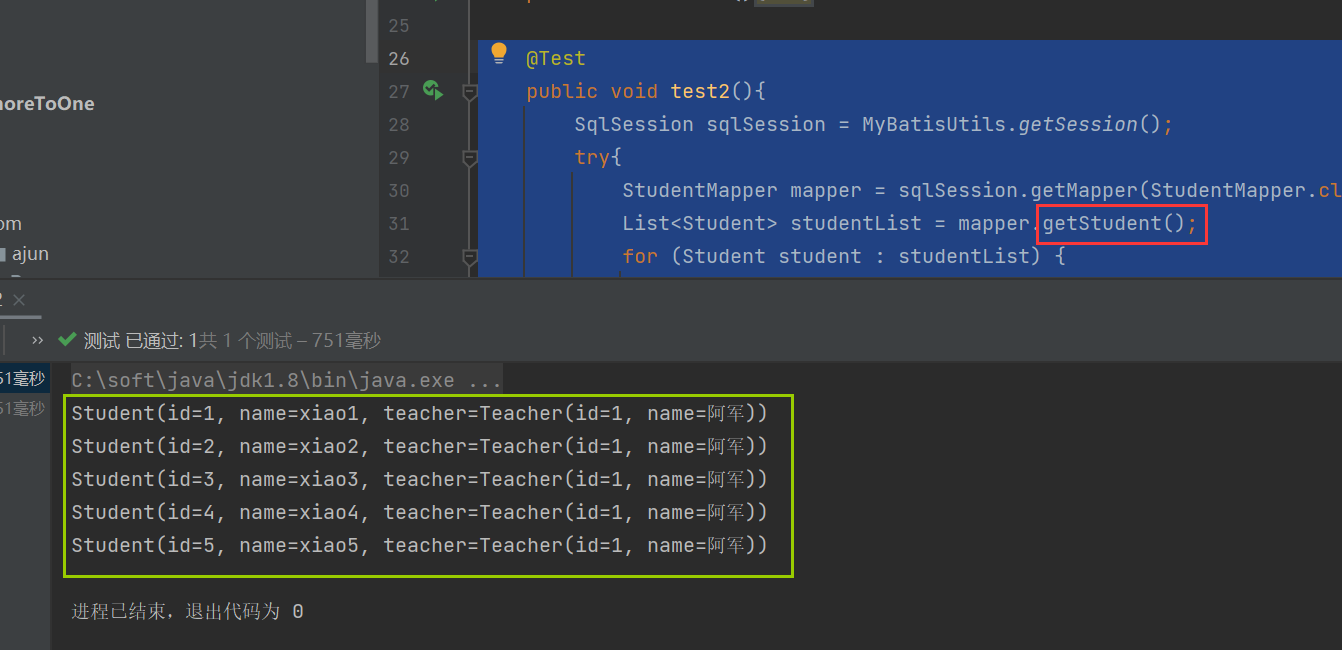
13.4、联表查询:结果嵌套处理(推荐)
- mapper.xml
<!--按照结果嵌套处理-->
<select id="getStudent2" resultMap="studentTeacher2">
select s.id sid,s.name sname,t.id tid,t.name tname
from mybatis.student s,mybatis.teacher t
where s.tid = t.id;
</select>
<resultMap id="studentTeacher2" type="student">
<result property="id" column="sid"/>
<result property="name" column="sname"/>
<association property="teacher" javaType="teacher">
<result property="name" column="tname"/>
<!--不指定id时,查询出的老师id为0-->
<!--<result property="id" column="tid"/>-->
</association>
</resultMap>
- 测试
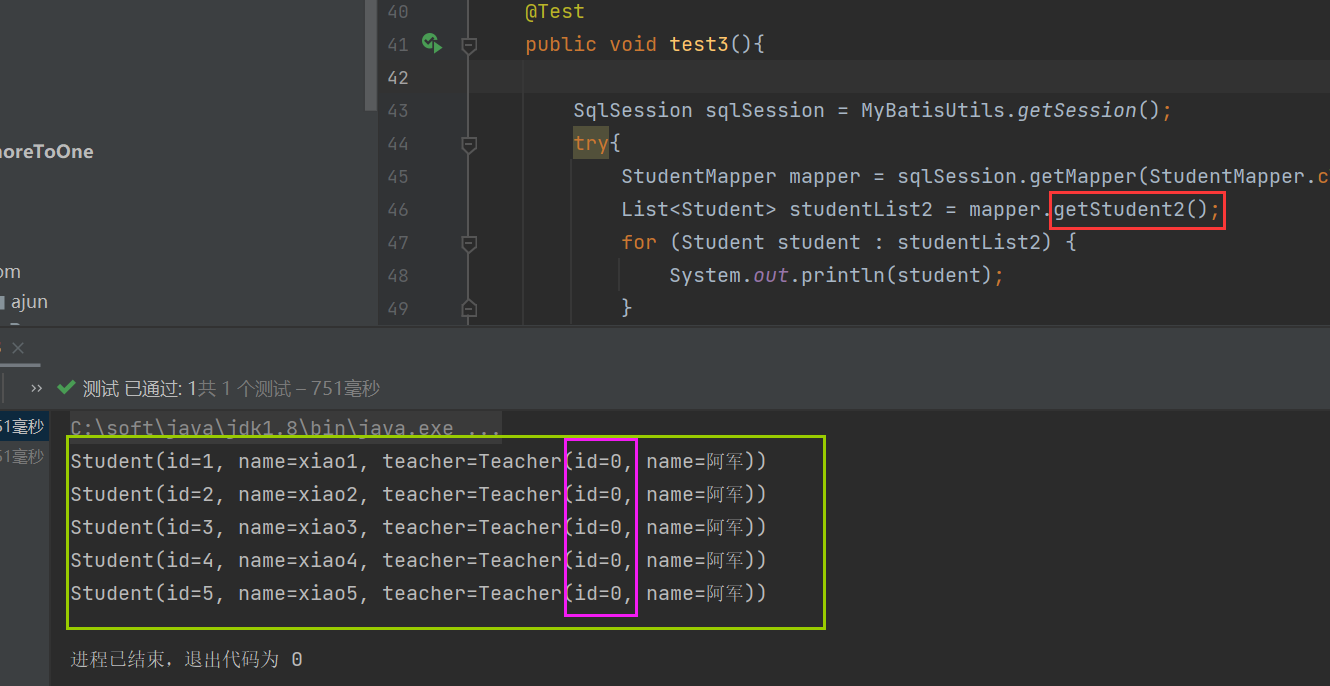
14、一对多
14.1、联表查询
1、实体类
学生类:Student.java
@Data
public class Student {
private int id;
private String name;
private int tid;
}
老师类:Teacher.java
@Data
public class Teacher {
private int id;
private String name;
private List<Student> students;
}
2、接口类
public interface TeacherMapper {
//获取所有老师
List<Teacher> getTeacher();
//获取特定老师及学生
Teacher getTeacherById(@Param("tid") int id);
}
3、接口配置TeacherMapper.xml
<!DOCTYPE mapper
PUBLIC "-//mybatis.org//DTD Mapper 3.0//EN"
"http://mybatis.org/dtd/mybatis-3-mapper.dtd">
<mapper namespace="com.ajun.mapper.TeacherMapper">
<select id="getTeacher" resultType="teacher">
select * from mybatis.teacher;
</select>
<select id="getTeacherById" resultMap="teacherStudent">
select t.id tid,t.name tname,s.id sid,s.name sname
from mybatis.teacher t,mybatis.student s
where t.id = #{tid} and t.id = s.tid
</select>
<resultMap id="teacherStudent" type="teacher">
<result property="id" column="tid"/>
<result property="name" column="tname"/>
<collection property="students" ofType="student">
<result property="id" column="sid"/>
<result property="name" column="sname"/>
<result property="tid" column="tid"/>
</collection>
</resultMap>
</mapper>
4、mybatis-config.xml 中添加mapper
就是告诉 MyBatis 去哪里找映射文件(SQL语句)。
不支持通配符。推荐用package,可以指定包下的所有配置文件。
resource和class需要一个一个地配置
四种配置方法。见5
5、工具类
同上
6、测试
@Test
public void test2() {
SqlSession sqlSession = MyBatisUtils.getSession();
try {
TeacherMapper mapper = sqlSession.getMapper(TeacherMapper.class);
Teacher teacher = mapper.getTeacherById(1);
System.out.println("===老师===");
System.out.println("id: "+teacher.getId());
System.out.println("姓名: "+teacher.getName());
List<Student> students = teacher.getStudents();
for (Student student : students) {
System.out.println(student);
}
} finally {
sqlSession.close();
}
}
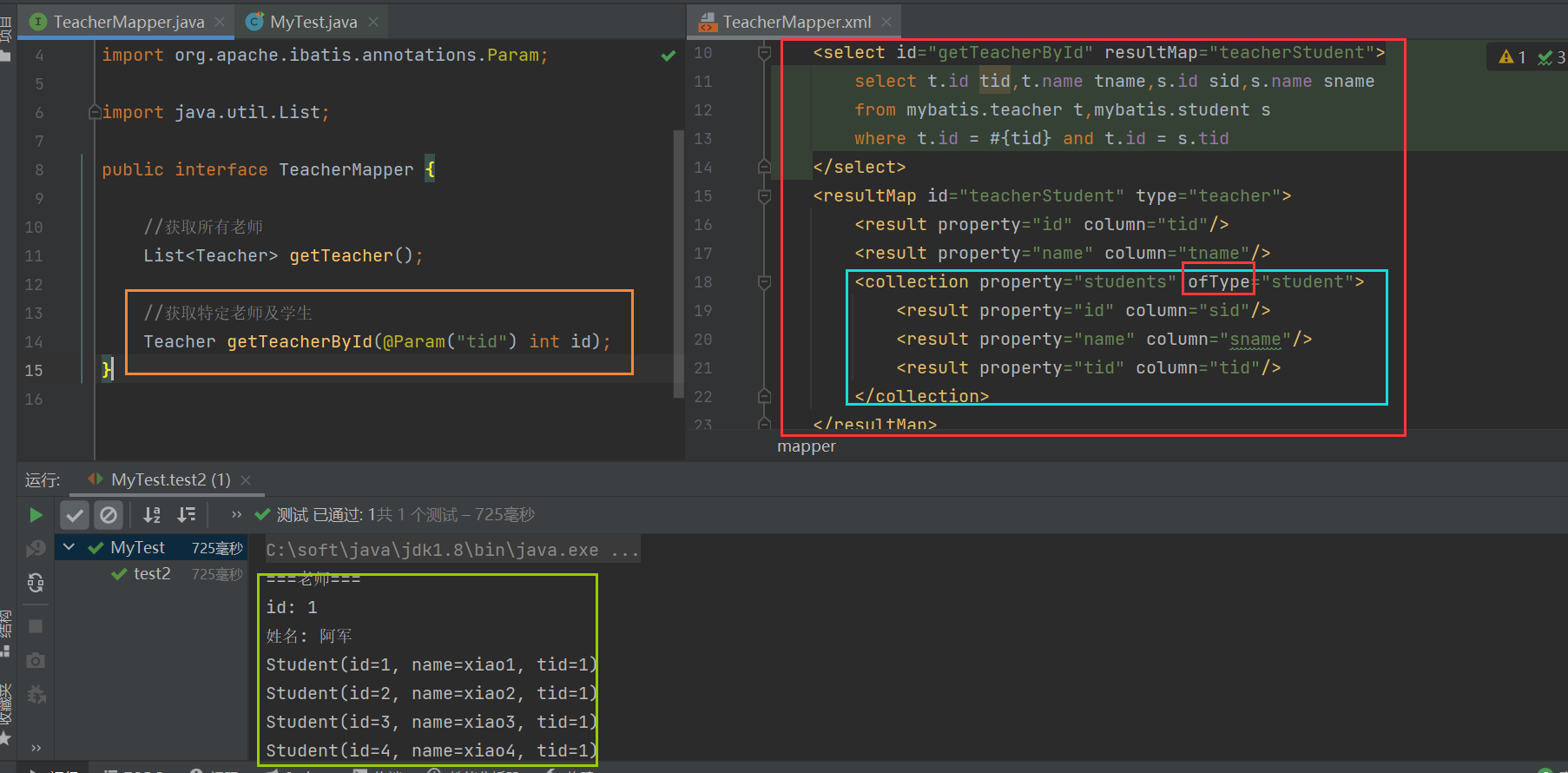
14.2、子查询
与14.1联表查询环境基本一致。主要改动为TeacherMapper.xml:
<!--子查询:按查询嵌套处理-->
<select id="getTeacherById2" resultMap="teacherStudent2">
select * from mybatis.teacher where id = #{tid};
</select>
<resultMap id="teacherStudent2" type="teacher">
<collection property="students" javaType="ArrayList"
ofType="student" select="getStudentByTeacherId"
column="id"/>
</resultMap>
<select id="getStudentByTeacherId" resultType="student">
select * from mybatis.student where tid = #{tid};
</select>

14.4、多对一 和 一对多 比较
-
都推荐用联表查询
-
多对一:结果集映射用 association 表示一个实体,指向 一 的一方。类型为:javaType
<!--子查询--> <association property="teacher" column="tid" javaType="teacher" select="getTeacher"/> <!--联表查询--> <association property="teacher" javaType="teacher"> <result property="name" column="tname"/> <!--不指定id时,查询出的老师id为0--> <!--<result property="id" column="tid"/>--> </association> -
一对多:结果集映射用 collection 表示集合,指向 多 的一方。
子查询中用javaType表示结果集(ArrayList),用ofType表示结果集中的对象student
<!--子查询--> <collection property="students" javaType="ArrayList" ofType="student" select="getStudentByTeacherId" column="id"/> <!--联表查询--> <collection property="students" ofType="student"> <result property="id" column="sid"/> <result property="name" column="sname"/> <!-- 名字相同时可以省略 <result property="tid" column="tid"/> --> </collection>
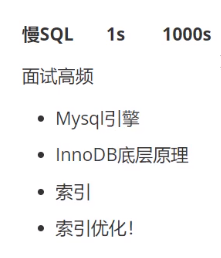
15、动态SQL
动态 SQL 是 MyBatis 的强大特性之一。可以根据条件动态地生成SQL
15.1、环境搭建
1、建表
CREATE TABLE `blog`(
`id` VARCHAR(50) NOT NULL COMMENT '博客ID',
`title` VARCHAR(100) NOT NULL COMMENT '博客标题',
`author` VARCHAR(30) NOT NULL COMMENT '博客作者',
`create_time` DATETIME NOT NULL COMMENT '创建时间',
`views` INT(30) NOT NULL COMMENT '浏览量',
PRIMARY KEY (`id`)
)ENGINE=INNODB DEFAULT CHARSET=utf8
2、工具类
-
IDUtils.java
生成随机id,并去掉 - (把 - 换成空)
public class IDUtils {
//随机生成随机id,把-换成空
public static String getId(){
return UUID.randomUUID().toString().replaceAll("-","");
}
}
-
MyBatisUtils.java
和之前相同
3、实体类 Blog.java
@Data
public class Blog {
private String id;
private String title;
private String author;
private Date createTime;
private int views;
}
4、Mapper接口类
//BlogMapper.java
public interface BlogMapper {
//添加
int addBlog(Blog blog);
}
5、配置文件
- mybatis-config.xml
<settings>
<setting name="logImpl" value="STDOUT_LOGGING"/>
<!--开启驼峰命名自动映射:
即从经典数据库列名 CREATE_TIME 映射到经典 Java 属性名 createTime-->
<setting name="mapUnderscoreToCamelCase" value="true"/>
</settings>
-
BlogMapper.xml
放在resources下的对应目录中,maven不用做静态资源过滤
<!--插入博客-->
<insert id="addBlog" parameterType="blog">
insert into mybatis.blog(id, title, author, create_time, views)
values (#{id},#{title},#{author},#{createTime},#{views});
</insert>
6、测试
@Test
public void test1(){
SqlSession sqlSession = MyBatisUtils.getSession();
try{
BlogMapper mapper = sqlSession.getMapper(BlogMapper.class);
Blog blog = new Blog();
blog.setId(IDUtils.getId());
blog.setAuthor("ajun");
blog.setCreateTime(new Date());
blog.setViews(999);
blog.setTitle("红楼梦");
mapper.addBlog(blog);
blog.setId(IDUtils.getId());
blog.setTitle("水浒传");
mapper.addBlog(blog);
blog.setId(IDUtils.getId());
blog.setTitle("西游记");
mapper.addBlog(blog);
blog.setId(IDUtils.getId());
blog.setTitle("三国演义");
mapper.addBlog(blog);
sqlSession.commit();//提交事务
}finally {
sqlSession.close();
}
}

15.2、if标签
- 接口类增加方法:
//查询
List<Blog> getBlogByMap(Map map);
- BlogMapper.xml
<!--查询-->
<select id="getBlogByMap" parameterType="map" resultType="blog">
select * from mybatis.blog where views > 500
<if test="title != null">
AND title like #{title}
</if>
<if test="author != null">
AND author like #{author}
</if>
</select>
根据title和author是否为空,可以动态生成SQL
默认SQL:
select * from mybatis.blog where views > 500
title不为空时:
select * from mybatis.blog where views > 500 and title like #{title}
author不为空时:
select * from mybatis.blog where views > 500 and author like #{author}
- 测试
@Test
public void test2(){
SqlSession sqlSession = MyBatisUtils.getSession();
try{
BlogMapper blogMapper = sqlSession.getMapper(BlogMapper.class);
Map<String,Object> map = new HashMap<String,Object>();
map.put("title","西游记");
//map.put("author","aaa");
List<Blog> blogs = blogMapper.getBlogByMap(map);
for (Blog blog : blogs) {
System.out.println(blog);
}
}finally {
sqlSession.close();
}
}
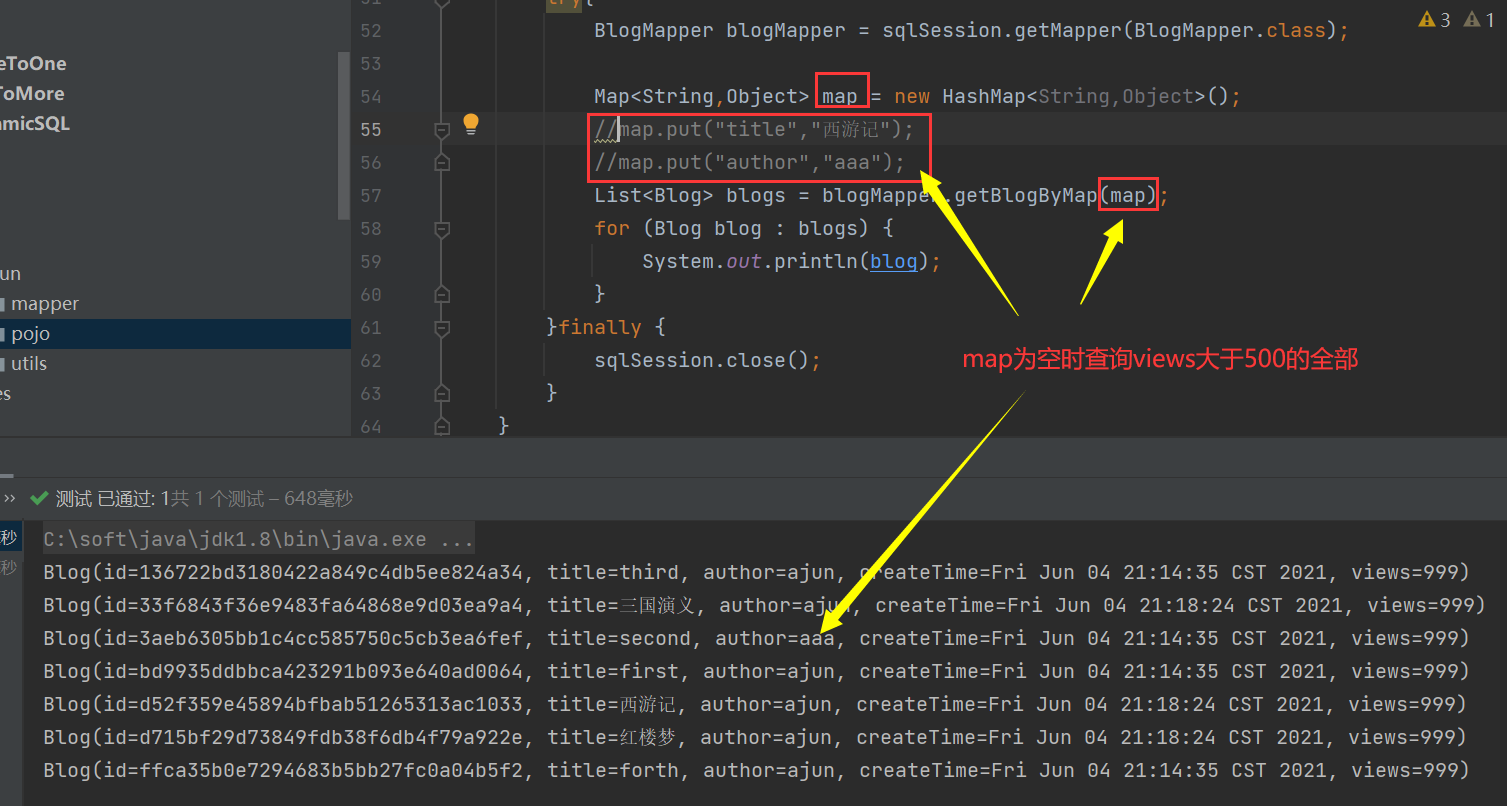
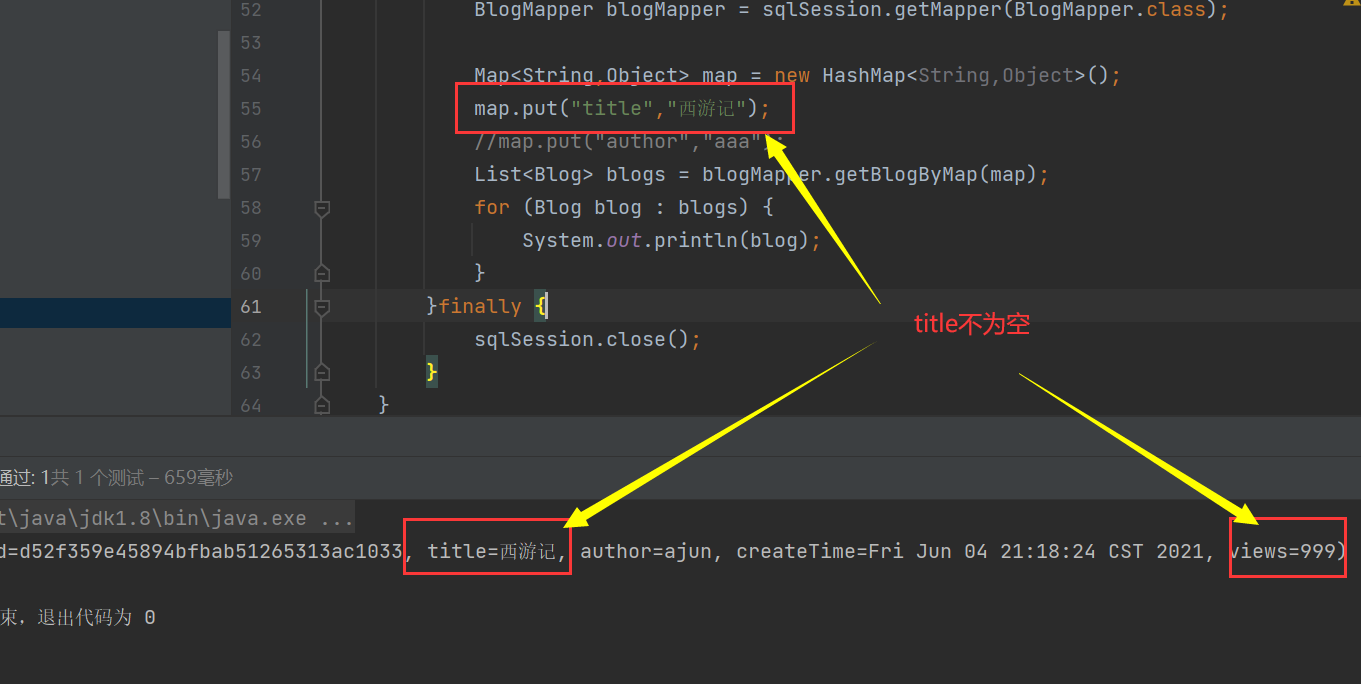
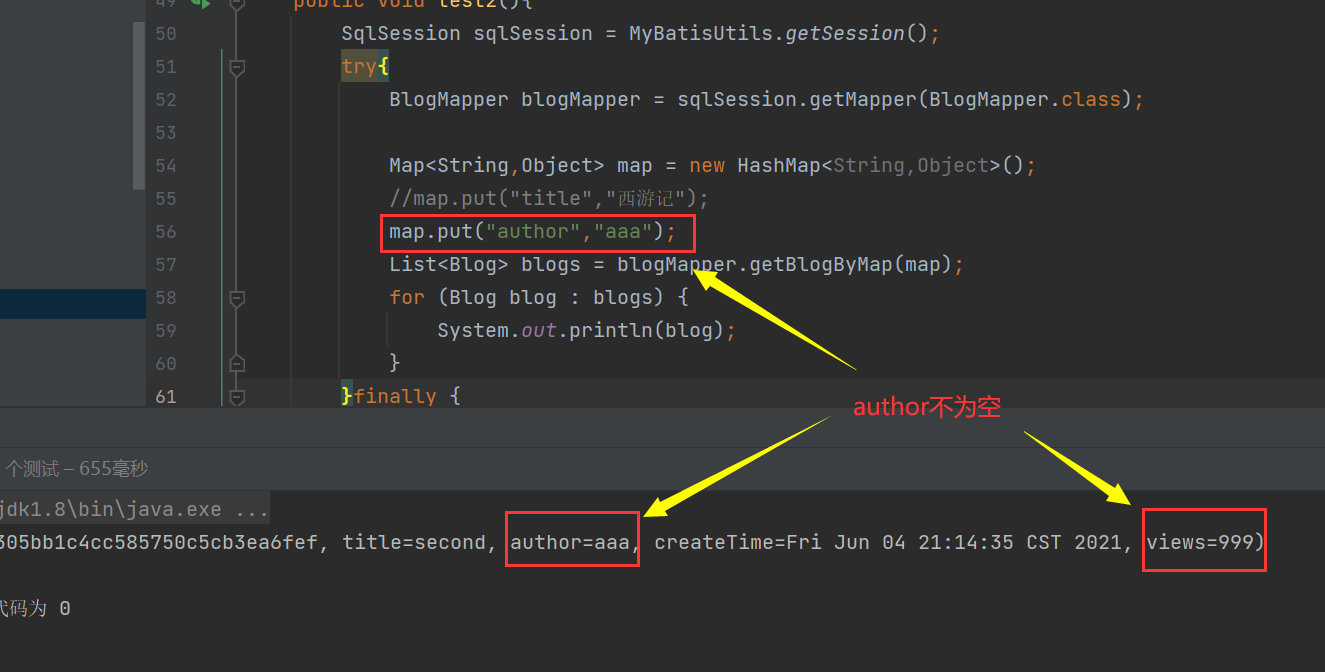
15.3、where标签
<!--查询-->
<select id="getBlogByMap" parameterType="map" resultType="blog">
select * from mybatis.blog
<where>
<if test="views != 0">
views > 500
</if>
<if test="title != null">
AND title like #{title}
</if>
<if test="author != null">
AND author like #{author}
</if>
</where>
</select>
where 元素只会在子元素返回任何内容的情况下才插入 “WHERE” 子句。而且,若子句的开头为 “AND” 或 “OR”,where 元素也会将它们去除
15.3、choose(when、otherwise)标签
按顺序只选择其中的一个条件
where和choose配合使用
<select id="getBlogByChoose" parameterType="map" resultType="blog">
select * from mybatis.blog
<where>
<choose>
<when test="title != null">
title like #{title}
</when>
<when test="author != null">
and author like #{author}
</when>
<otherwise>
and views > 500
</otherwise>
</choose>
</where>
</select>
15.4、set标签
<update id="updateAuthorIfNecessary">
update Author
<set>
<if test="username != null">username=#{username},</if>
<if test="password != null">password=#{password},</if>
<if test="email != null">email=#{email},</if>
<if test="bio != null">bio=#{bio}</if>
</set>
where id=#{id}
</update>
set元素会动态地在行首插入 SET 关键字,并会删掉额外的逗号(这些逗号是在使用条件语句给列赋值时引入的)
set元素中间的判断条件要有至少一个成立
15.5、trim标签
trim为自定义标签,可以替换where和set
<trim prefix="WHERE" prefixOverrides="AND |OR ">
...
</trim>
prefixOverrides 属性会忽略通过管道符分隔的文本序列(注意此例中的空格是必要的)。上述例子会移除所有 prefixOverrides 属性中指定的内容,并且插入 prefix 属性中指定的内容。
<trim prefix="SET" suffixOverrides=",">
...
</trim>
set 元素会动态地在行首插入 SET 关键字,并会删掉额外的逗号(这些逗号是在使用条件语句给列赋值时引入的)
15.6、SQL片段
有些时候我们有一些公共部分
- 使用sql便签抽取公共部分
- 在使用的地方使用include标签
<sql id="if-title-author">
<if test="title != null">
title = #{title}
</if>
<if test="author != null">
and author = #{author}
</if>
</sql>
<select id="queryBlogIF" parameterType="map" resultType="blog">
select * from mybatis.blog
<where>
<include refid="if-title-author"></include>
</where>
</select>
注意:
-
最好基于单表
-
sql里不要存在where标签
-
了解即可
15.7、foreach
动态 SQL 的另一个常见使用场景是对集合进行遍历(尤其是在构建 IN 条件语句的时候)。比如:
<!--
select * from blog where id in (1,2,3,4)
-->
<select id="selectPostIn" resultType="blog">
select * from blog where id in
<foreach item="item" index="index" collection="ids"
open="(" separator="," close=")">
#{item}
</foreach>
</select>
<!--
select * from blog where (id = 1 or id =2 or id =3)
-->
<select id="selectPostIn" resultType="blog">
select * from blog
<where>
<foreach item="item" index="index" collection="ids"
open="(" separator="or" close=")">
#{item}
</foreach>
</where>
</select>
foreach 元素的功能非常强大,它允许你指定一个集合,声明可以在元素体内使用的集合项(item)和索引(index)变量。它也允许你指定开头与结尾的字符串以及集合项迭代之间的分隔符。这个元素也不会错误地添加多余的分隔符,看它多智能!
提示 你可以将任何可迭代对象(如 List、Set 等)、Map 对象或者数组对象作为集合参数传递给 foreach。当使用可迭代对象或者数组时,index 是当前迭代的序号,item 的值是本次迭代获取到的元素。当使用 Map 对象(或者 Map.Entry 对象的集合)时,index 是键,item 是值。
16、缓存
16.1、简介
查询 : 连接数据库,耗资源
一次查询的结果,给他暂存一个可以直接取到的地方 --> 内存:缓存
我们再次查询的相同数据的时候,直接走缓存,不走数据库了
12345
- 什么是缓存Cache?
- 存在内存中的临时数据
- 将用户经常查询的数据放在缓存(内存)中,用户去查询数据就不用从磁盘上(关系型数据库文件)查询,从缓存中查询,从而提高查询效率,解决了高并发系统的性能问题
- 为什么使用缓存?
- 减少和数据库的交互次数,减少系统开销,提高系统效率
- 什么样的数据可以使用缓存?
- 经常查询并且不经常改变的数据 【可以使用缓存】
16.2、MyBatis缓存
- MyBatis包含一个非常强大的查询缓存特性,它可以非常方便的定制和配置缓存,缓存可以极大的提高查询效率。
- MyBatis系统中默认定义了两级缓存:一级缓存和二级缓存
- 默认情况下,只有一级缓存开启(SqlSession级别的缓存,也称为本地缓存)
- 二级缓存需要手动开启和配置,他是基于namespace级别的缓存。
- 为了提高可扩展性,MyBatis定义了缓存接口Cache。我们可以通过实现Cache接口来定义二级缓存。
16.3、一级缓存
也叫本地缓存:SqlSession
- 与数据库同一次会话期间查询到的数据会放在本地缓存中
- 以后如果需要获取相同的数据,直接从缓存中拿,没必要再去查询数据库
- 一级缓存的生命周期:最长不超过从SqlSession创建到关闭。如果执行了非查询操作,缓存会被刷新。
一级缓存不能关闭,可以配置。默认为session。
| 设置名 | 描述 | 有效值 | 默认值 |
|---|---|---|---|
| localCacheScope | MyBatis 利用本地缓存机制(Local Cache)防止循环引用和加速重复的嵌套查询。 默认值为 SESSION,会缓存一个会话中执行的所有查询。 若设置值为 STATEMENT,本地缓存将仅用于执行语句,对相同 SqlSession 的不同查询将不会进行缓存。 | SESSION | STATEMENT | SESSION |
测试:
- 开启日志
<settings>
<setting name="logImpl" value="STDOUT_LOGGING"/>
</settings>
- 测试在一个Session中查询两次相同记录
@Test
public void test(){
SqlSession sqlSession = MyBatisUtils.getSession();
try{
UserMapper mapper = sqlSession.getMapper(UserMapper.class);
User user1 = mapper.getUserById(4);
System.out.println("第一次:"+user1);
System.out.println("-----------------------");
User user2 = mapper.getUserById(4);
System.out.println("第二次:"+user2);
System.out.println(user1==user2);
}finally {
sqlSession.close();
}
}
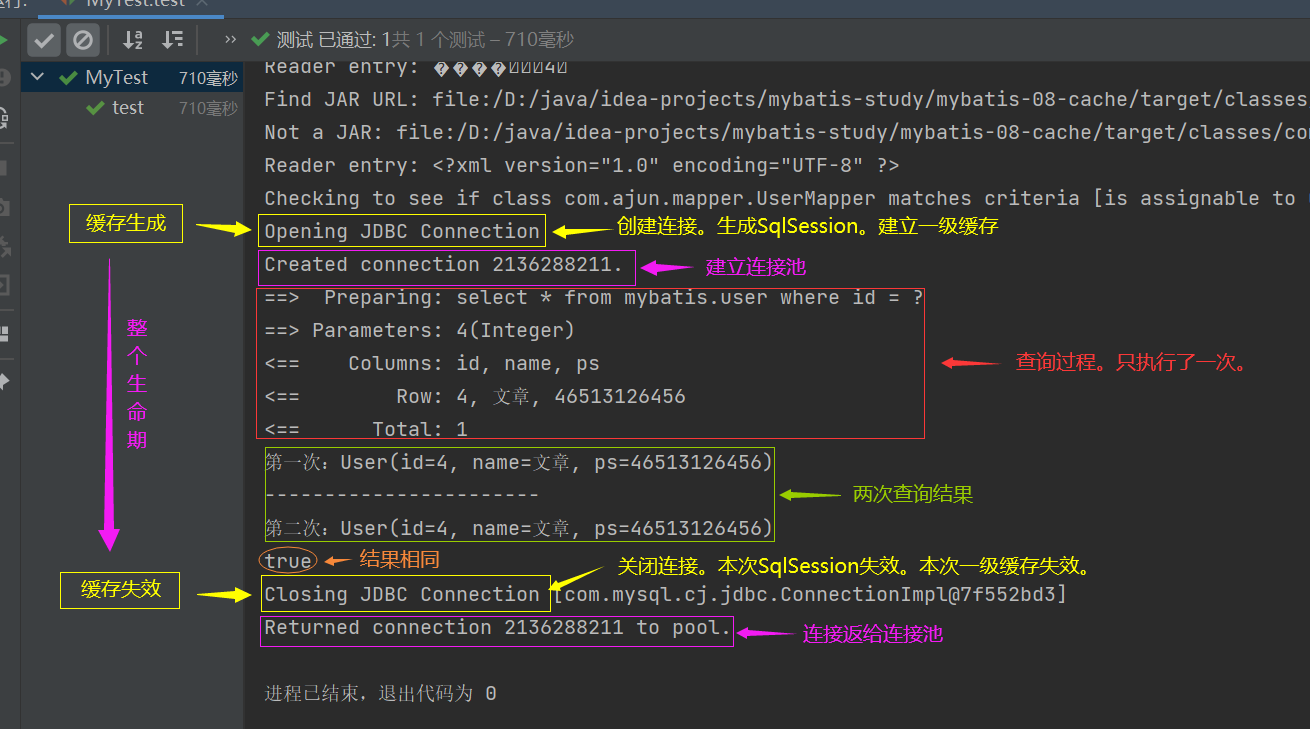
缓存失效的情况:
-
查询不同的东西
-
增删改操作,可能会改变原来的数据,所以必定会刷新缓存
-
查询不同的Mapper.xml
-
手动清理缓存
sqlSession.clearCache();
16.4、二级缓存
- 二级缓存也叫全局缓存,一级缓存作用域太低了,所以诞生了二级缓存
- 基于namespace级别的缓存,一个名称空间,对应一个二级缓存
- 工作机制
- 一个会话查询一条数据,这个数据就会被放在当前会话的一级缓存中
- 如果会话关闭了,这个会话对应的一级缓存就没了;但是我们想要的是,会话关闭了,一级缓存中的数据被保存到二级缓存中
- 新的会话查询信息,就可以从二级缓存中获取内容
- 不同的mapper查询出的数据会放在自己对应的缓存(map)中
一级缓存开启(SqlSession级别的缓存,也称为本地缓存)
- 二级缓存需要手动开启和配置,他是基于namespace级别的缓存。
- 为了提高可扩展性,MyBatis定义了缓存接口Cache。我们可以通过实现Cache接口来定义二级缓存。
二级缓存是事务性的。这意味着,当 SqlSession 完成并提交时,或是完成并回滚,但没有执行 flushCache=true 的 insert/delete/update 语句时,缓存会获得更新。
步骤:
1、开启全局缓存
默认是开启的:true。可以省略
<!--显式的开启全局缓存-->
<setting name="cacheEnabled" value="true"/>
2、在Mapper.xml中使用缓存
<!--在当前Mapper.xml中使用二级缓存-->
<cache/>
<!--
<cache
eviction="FIFO"
flushInterval="60000"
size="512"
readOnly="true"/>-->
3、实体类序列化
@Data
public class User implements Serializable {
private int id;
private String name;
private String ps;
}
4、测试
@Test
public void test1(){
//生成session1
SqlSession sqlSession1 = MyBatisUtils.getSession();
UserMapper mapper1 = sqlSession1.getMapper(UserMapper.class);
//查询用户4,存入一级缓存
User user1 = mapper1.getUserById(4);
System.out.println("1:"+user1);
//查询用户3,存入一级缓存
User user2 = mapper1.getUserById(3);
System.out.println("2:"+user2);
//重复查询用户3
User user3 = mapper1.getUserById(3);
System.out.println("3:"+user3);
//关闭session1,清空一级缓存
sqlSession1.close();
System.out.println("-----------------------");
//生成session2
SqlSession sqlSession2 = MyBatisUtils.getSession();
UserMapper mapper2 = sqlSession2.getMapper(UserMapper.class);
User user4 = mapper2.getUserById(3);
System.out.println("4:"+user4);
sqlSession2.close();
}
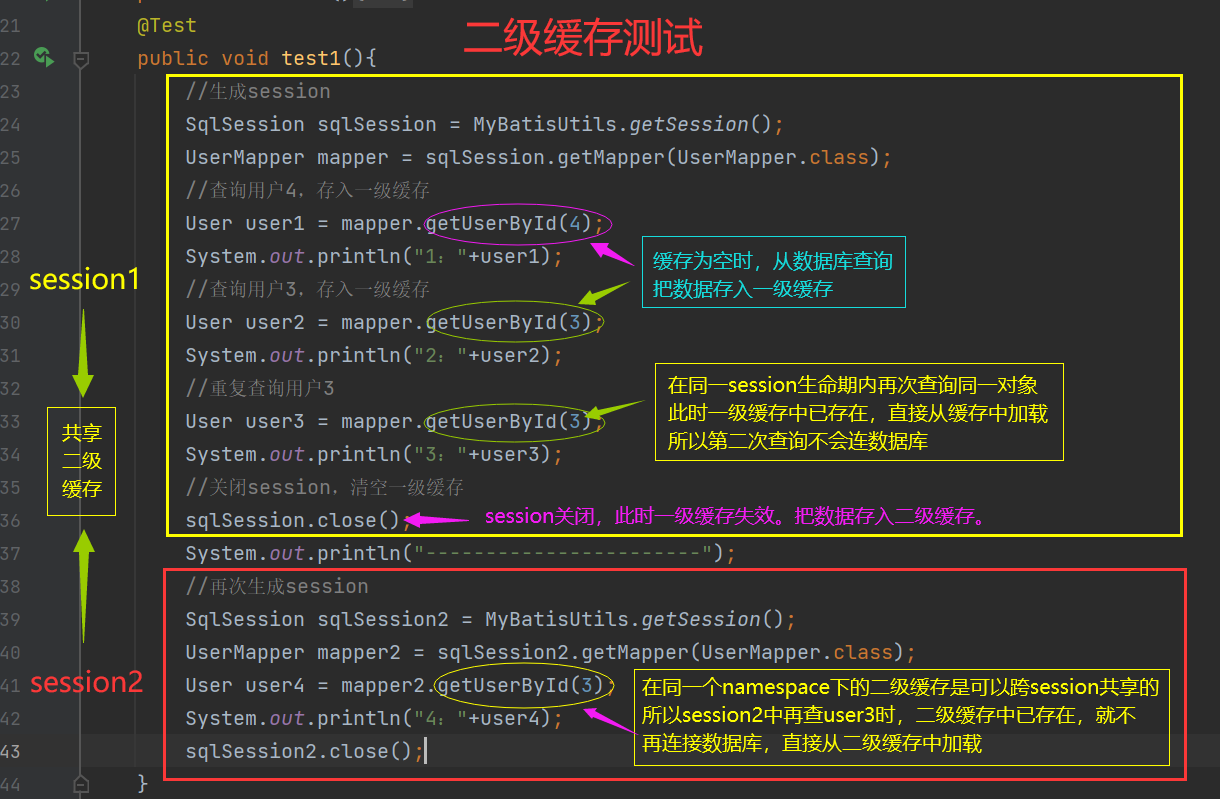
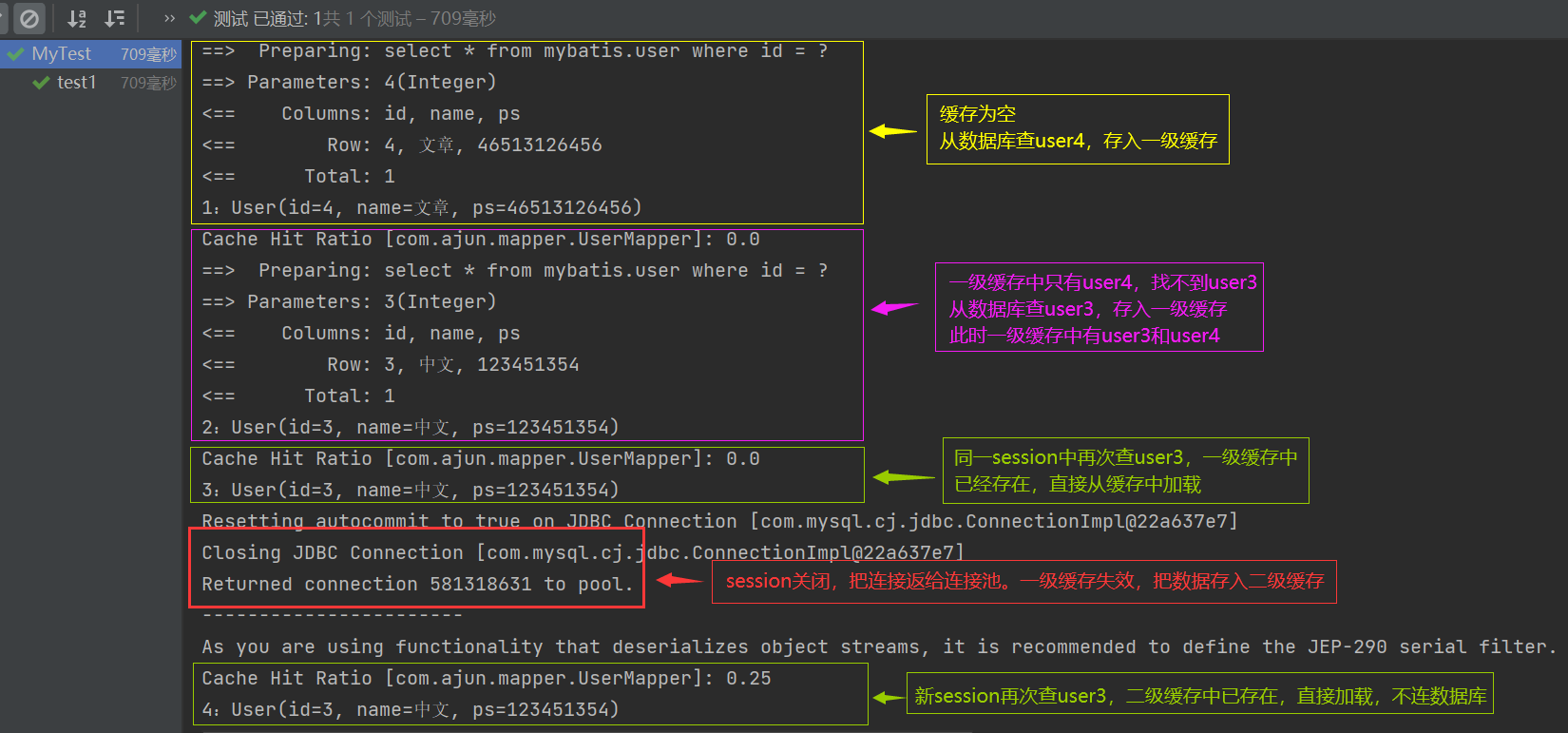
16.5、缓存原理
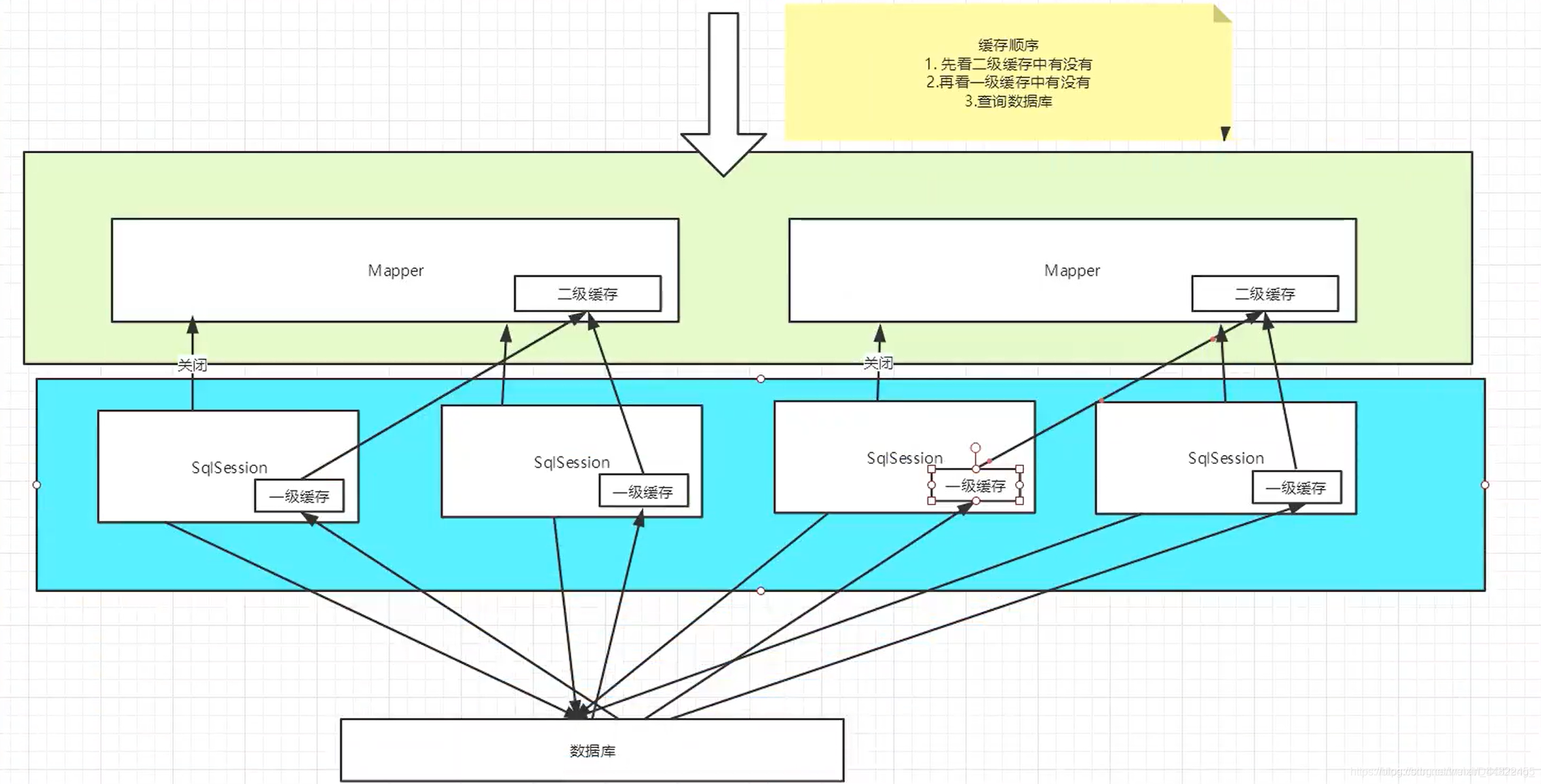

16.6、自定义缓存
Ehcache是一种广泛使用的开源Java分布式缓存。主要面向通用缓存
- 导包
<dependency>
<groupId>org.mybatis.caches</groupId>
<artifactId>mybatis-ehcache</artifactId>
<version>1.2.1</version>
</dependency>
- 在mapper中指定ehcache缓存实现
<cache type="org.mybatis.caches.ehcache.EhcacheCache"/>
- ehcache.xml
<?xml version="1.0" encoding="UTF-8"?>
<ehcache xmlns:xsi="http://www.w3.org/2001/XMLSchema-instance"
xsi:noNamespaceSchemaLocation="http://ehcache.org/ehcache.xsd"
updateCheck="false">
<!--
diskStore:为缓存路径,ehcache分为内存和磁盘两级,此属性定义磁盘的缓存位置。参数解释如下:
user.home – 用户主目录
user.dir – 用户当前工作目录
java.io.tmpdir – 默认临时文件路径
-->
<diskStore path="java.io.tmpdir/Tmp_EhCache"/>
<!--
defaultCache:默认缓存策略,当ehcache找不到定义的缓存时,则使用这个缓存策略。只能定义一个。
-->
<!--
name:缓存名称。
maxElementsInMemory:缓存最大数目
maxElementsOnDisk:硬盘最大缓存个数。
eternal:对象是否永久有效,一但设置了,timeout将不起作用。
overflowToDisk:是否保存到磁盘,当系统当机时
timeToIdleSeconds:设置对象在失效前的允许闲置时间(单位:秒)。仅当eternal=false对象不是永久有效时使用,可选属性,默认值是0,也就是可闲置时间无穷大。
timeToLiveSeconds:设置对象在失效前允许存活时间(单位:秒)。最大时间介于创建时间和失效时间之间。仅当eternal=false对象不是永久有效时使用,默认是0.,也就是对象存活时间无穷大。
diskPersistent:是否缓存虚拟机重启期数据 Whether the disk store persists between restarts of the Virtual Machine. The default value is false.
diskSpoolBufferSizeMB:这个参数设置DiskStore(磁盘缓存)的缓存区大小。默认是30MB。每个Cache都应该有自己的一个缓冲区。
diskExpiryThreadIntervalSeconds:磁盘失效线程运行时间间隔,默认是120秒。
memoryStoreEvictionPolicy:当达到maxElementsInMemory限制时,Ehcache将会根据指定的策略去清理内存。默认策略是LRU(最近最少使用)。你可以设置为FIFO(先进先出)或是LFU(较少使用)。
clearOnFlush:内存数量最大时是否清除。
memoryStoreEvictionPolicy:可选策略有:LRU(最近最少使用,默认策略)、FIFO(先进先出)、LFU(最少访问次数)。
FIFO,first in first out,这个是大家最熟的,先进先出。
LFU, Less Frequently Used,就是上面例子中使用的策略,直白一点就是讲一直以来最少被使用的。如上面所讲,缓存的元素有一个hit属性,hit值最小的将会被清出缓存。
LRU,Least Recently Used,最近最少使用的,缓存的元素有一个时间戳,当缓存容量满了,而又需要腾出地方来缓存新的元素的时候,那么现有缓存元素中时间戳离当前时间最远的元素将被清出缓存。
-->
<defaultCache
eternal="false"
maxElementsInMemory="10000"
overflowToDisk="false"
diskPersistent="false"
timeToIdleSeconds="1800"
timeToLiveSeconds="259200"
memoryStoreEvictionPolicy="LRU"/>
<cache
name="cloud_user"
eternal="false"
maxElementsInMemory="5000"
overflowToDisk="false"
diskPersistent="false"
timeToIdleSeconds="1800"
timeToLiveSeconds="1800"
memoryStoreEvictionPolicy="LRU"/>
</ehcache>
本文来自博客园,作者:土味儿,转载请注明原文链接:https://www.cnblogs.com/tuwer/articles/15131902.html


 浙公网安备 33010602011771号
浙公网安备 33010602011771号